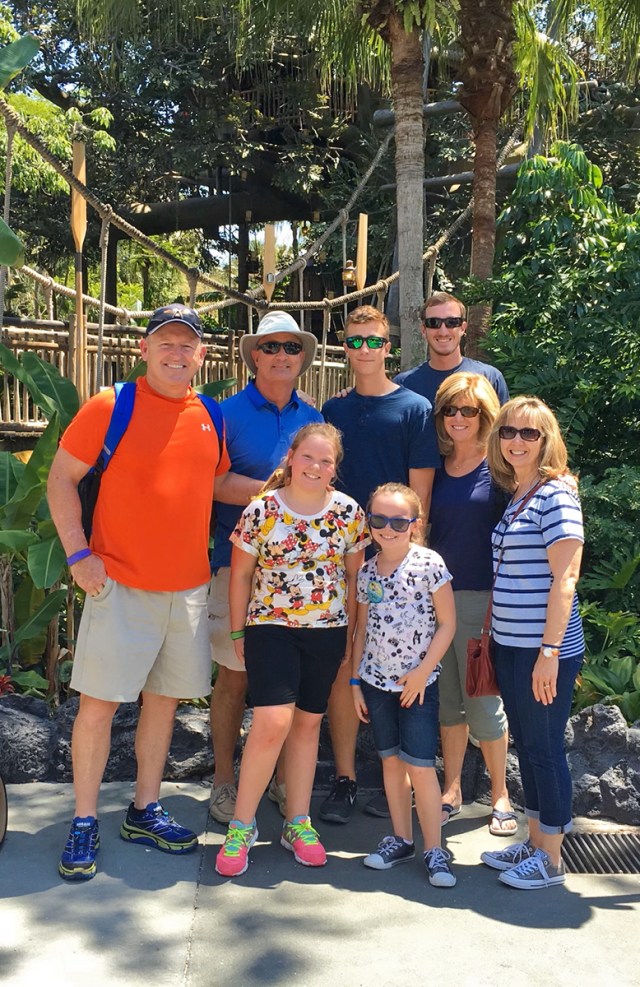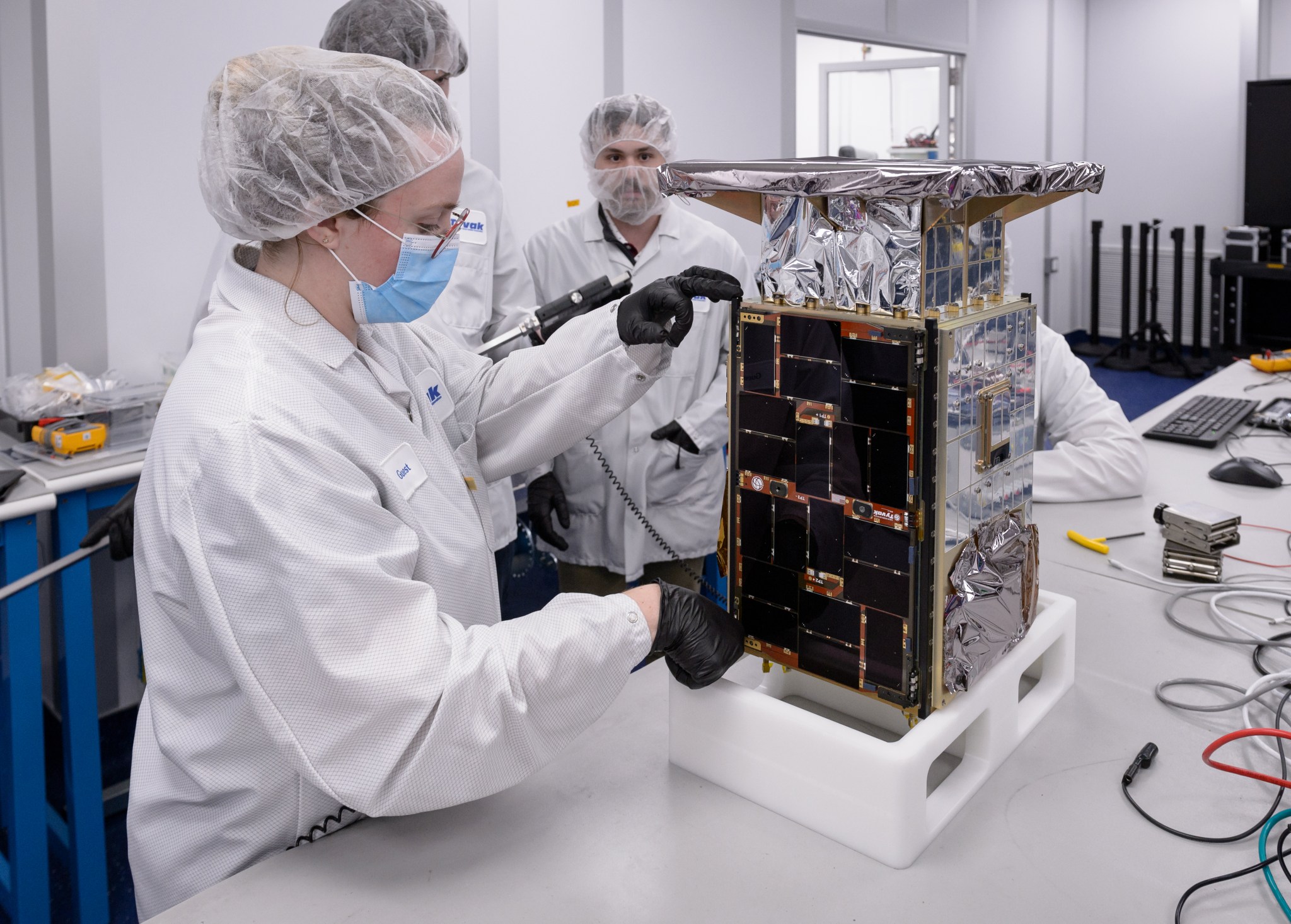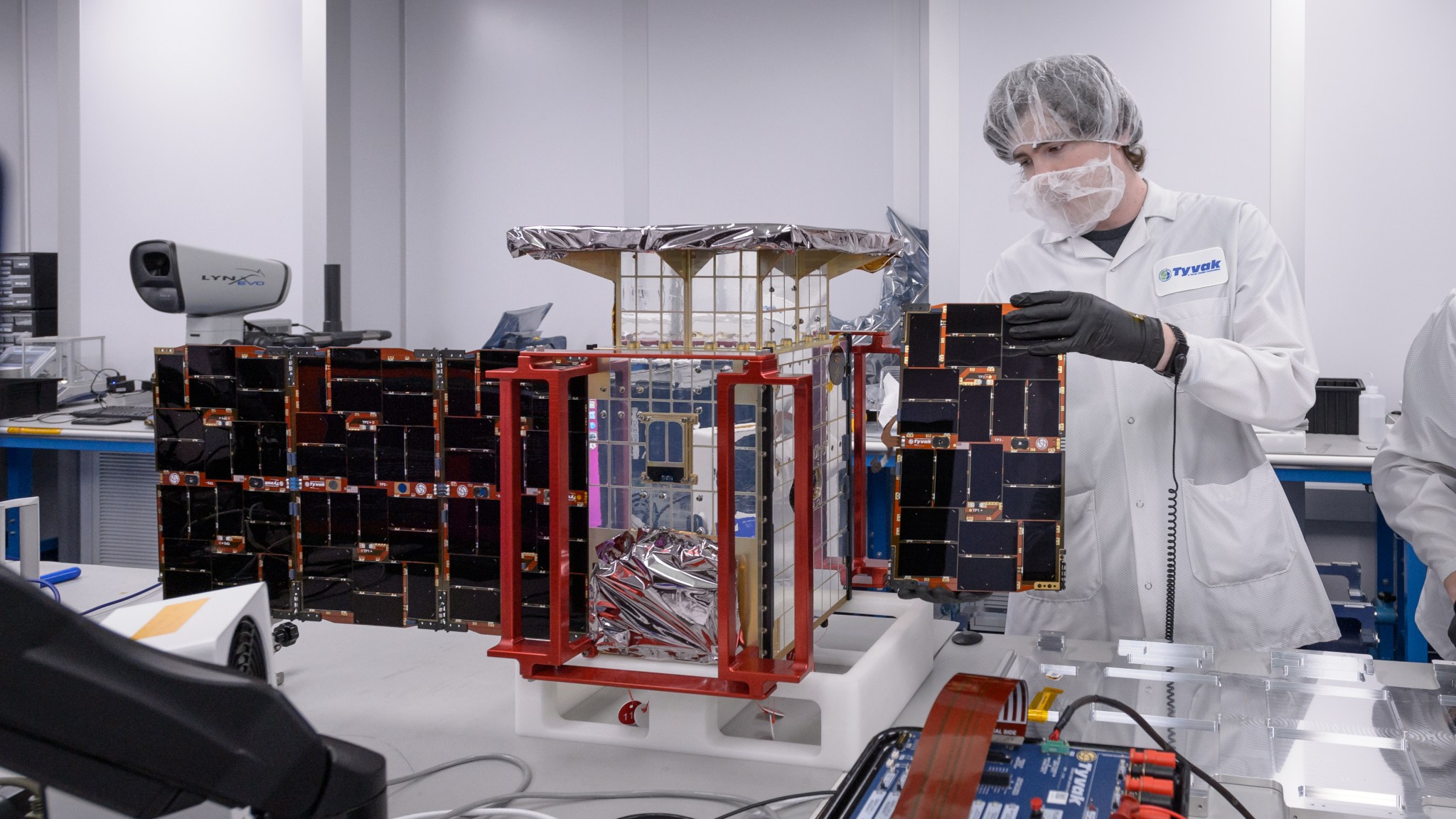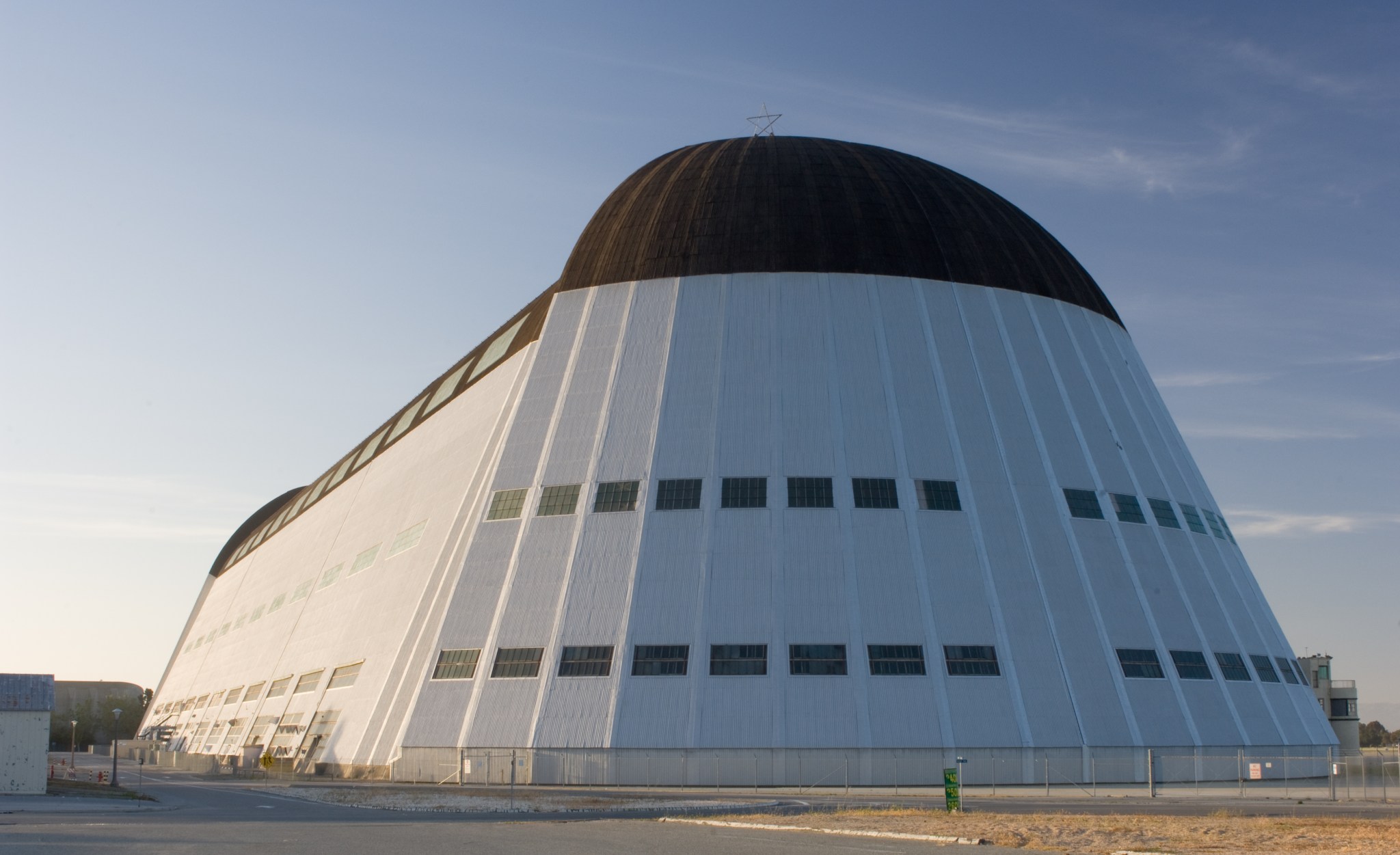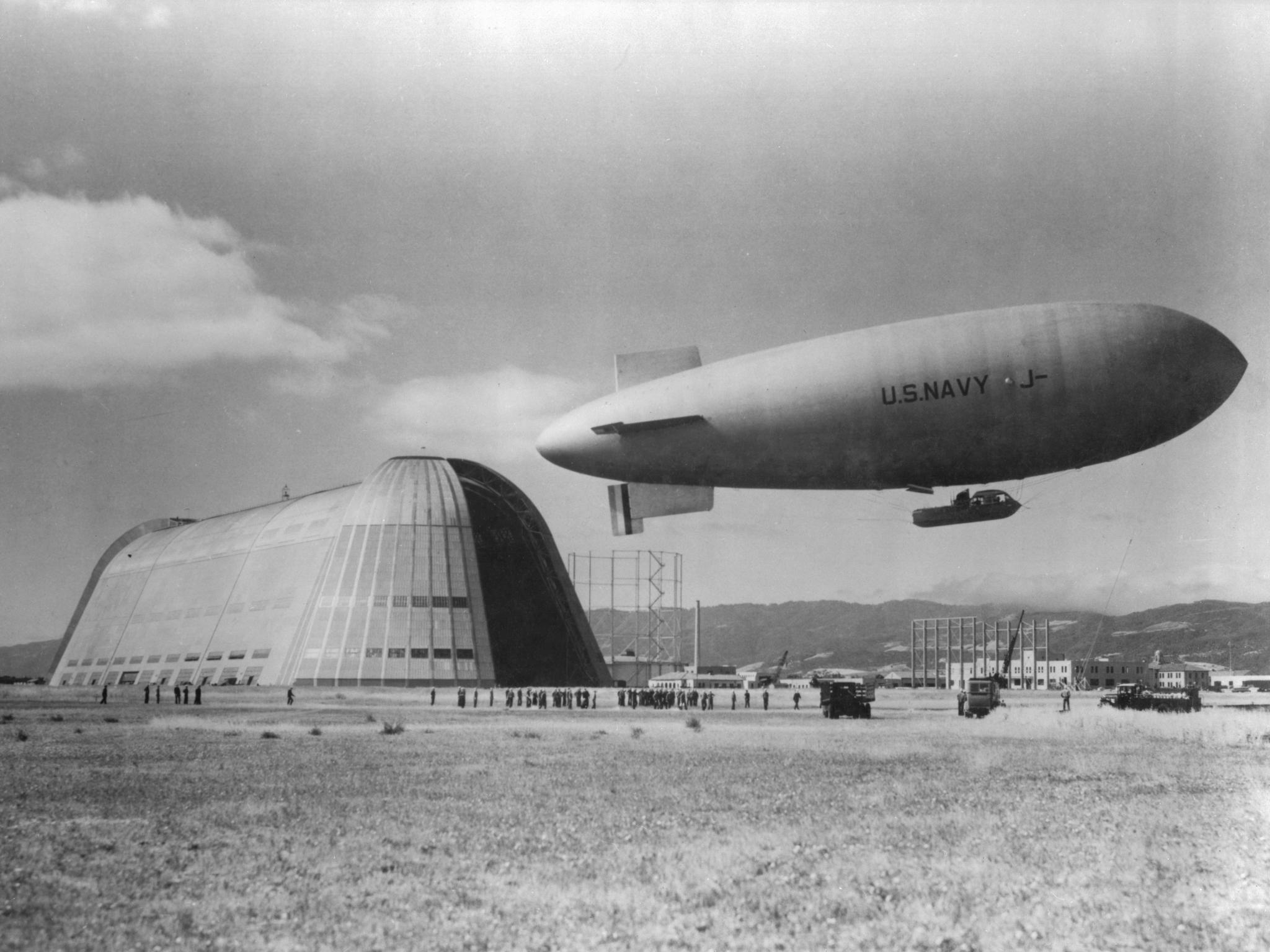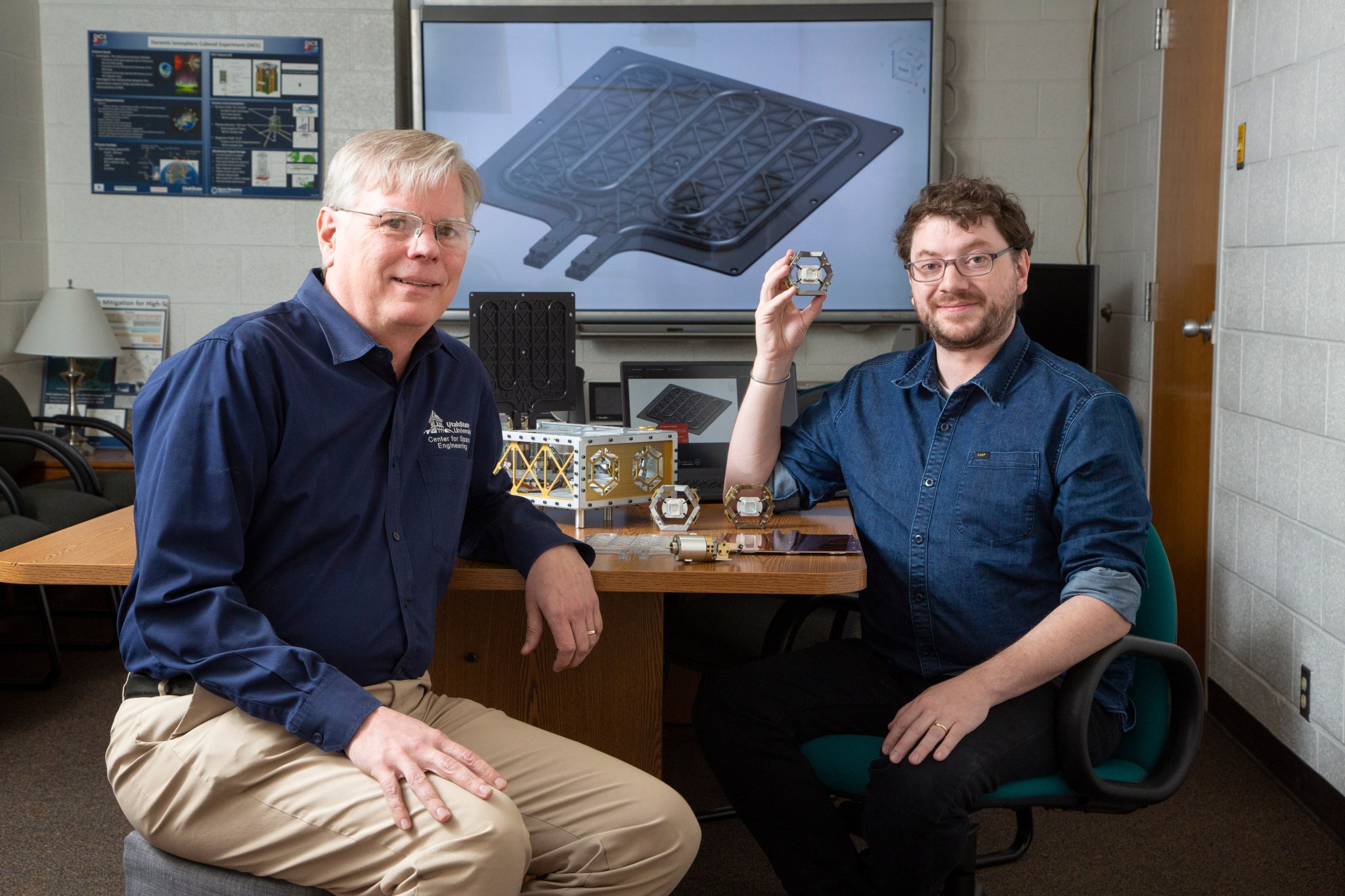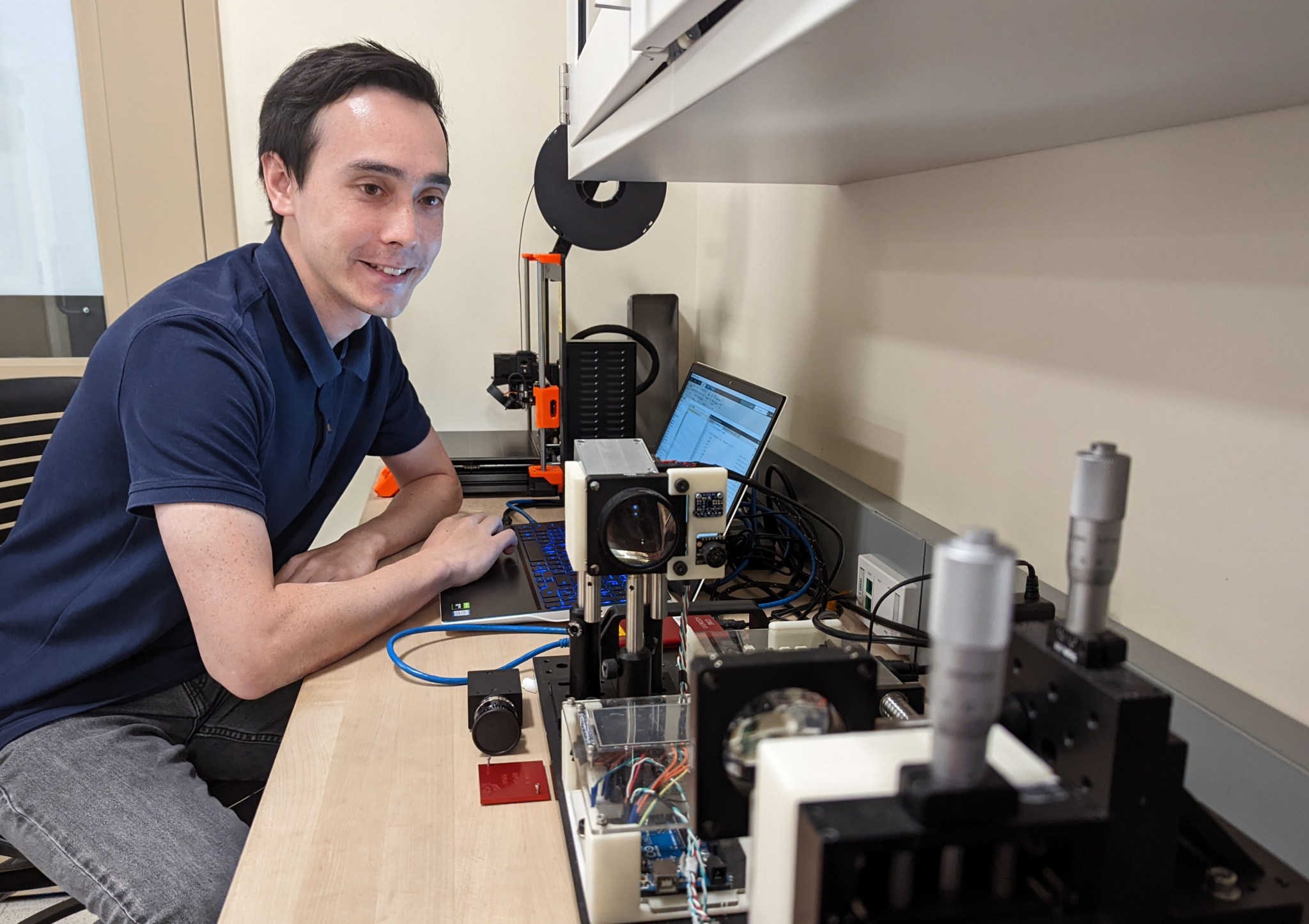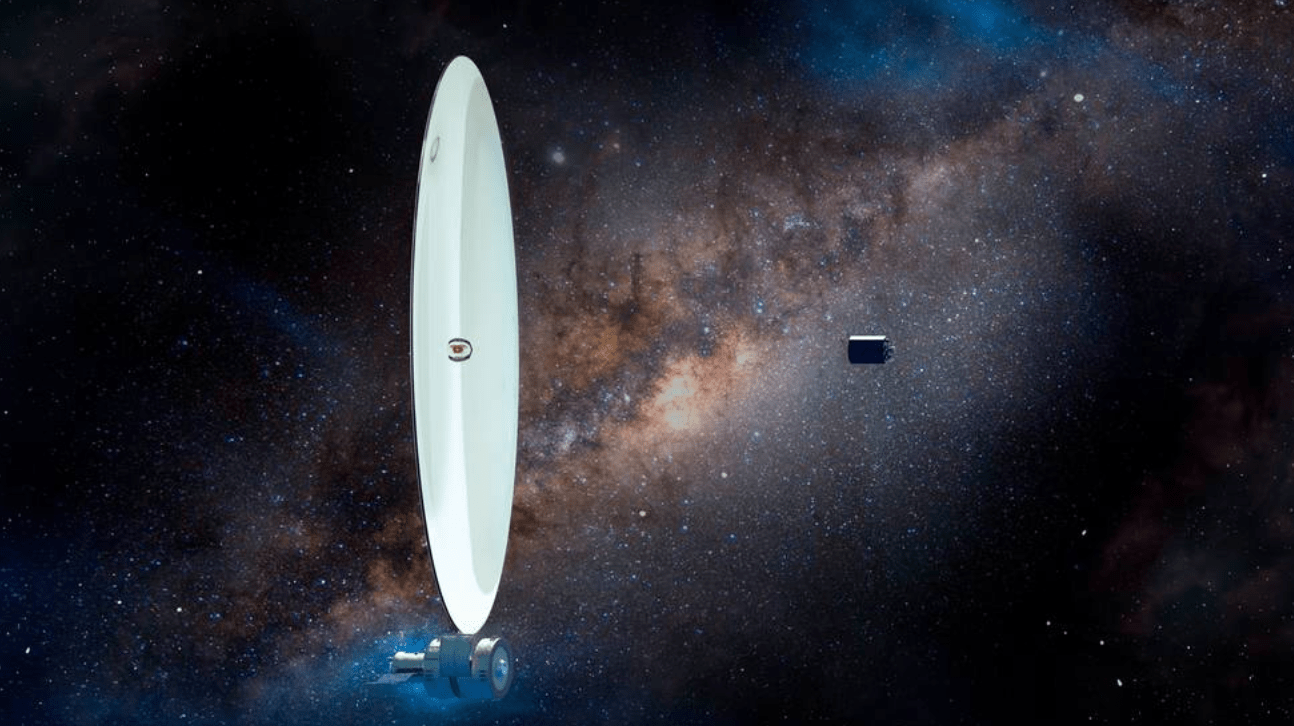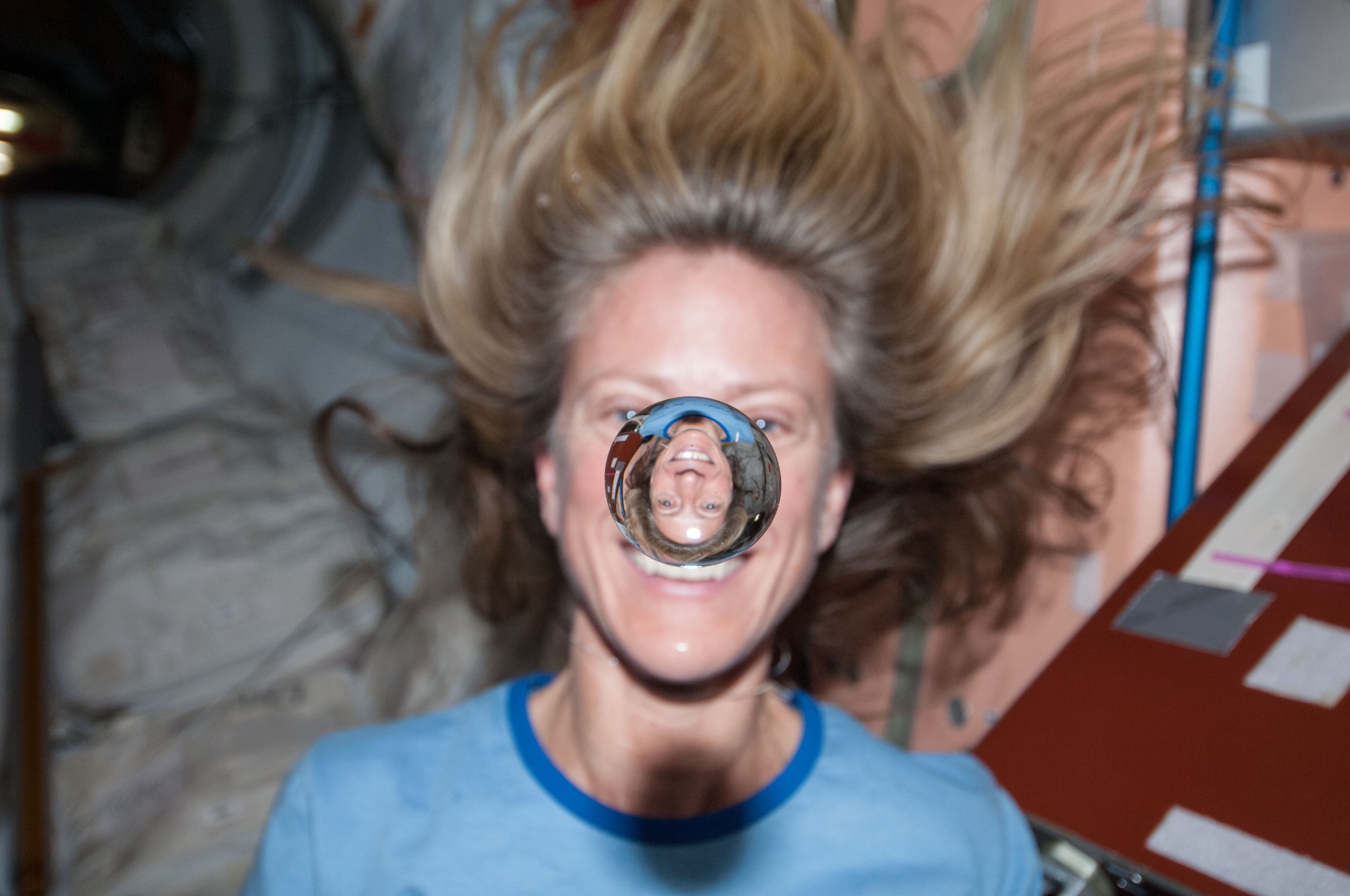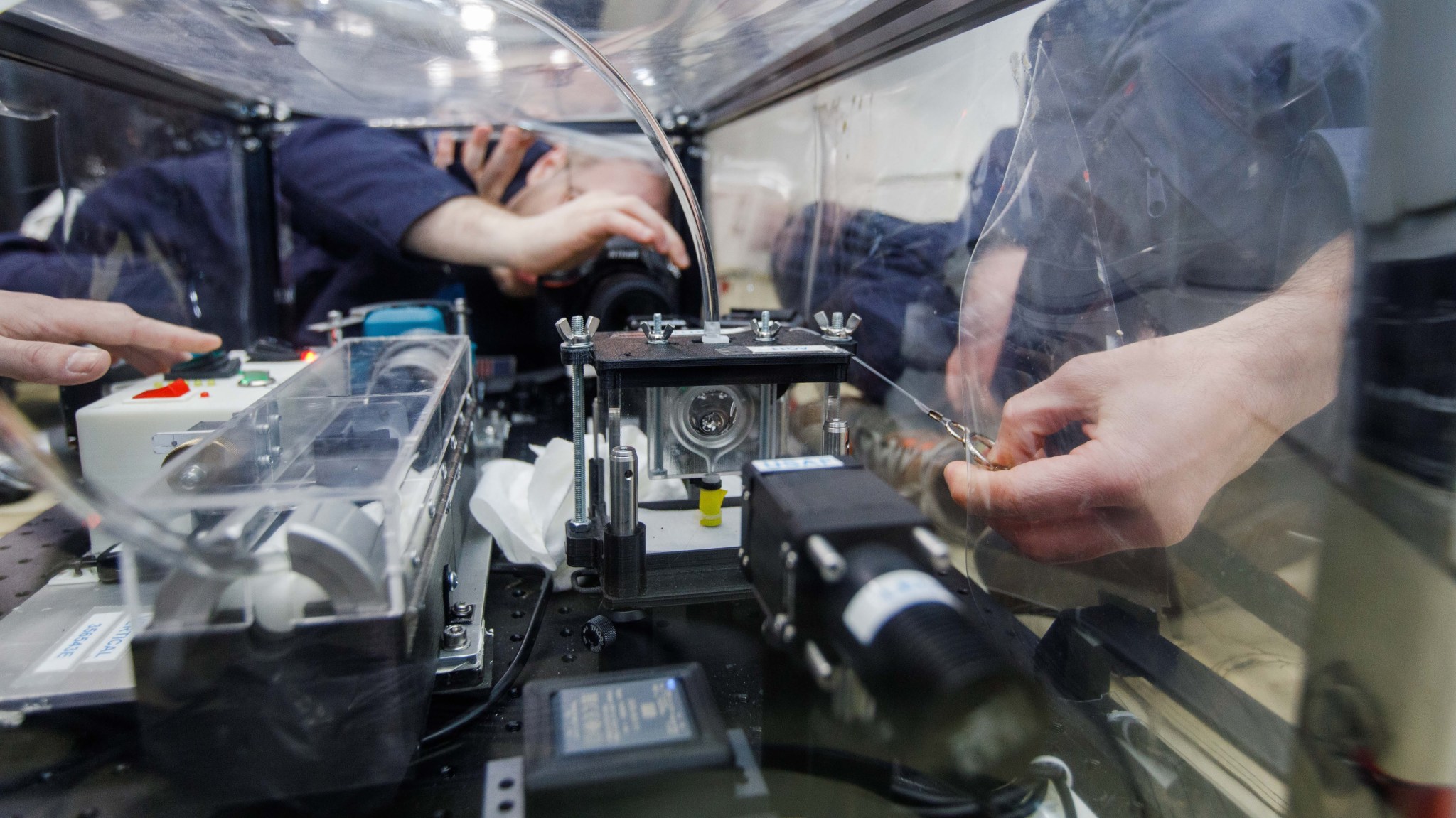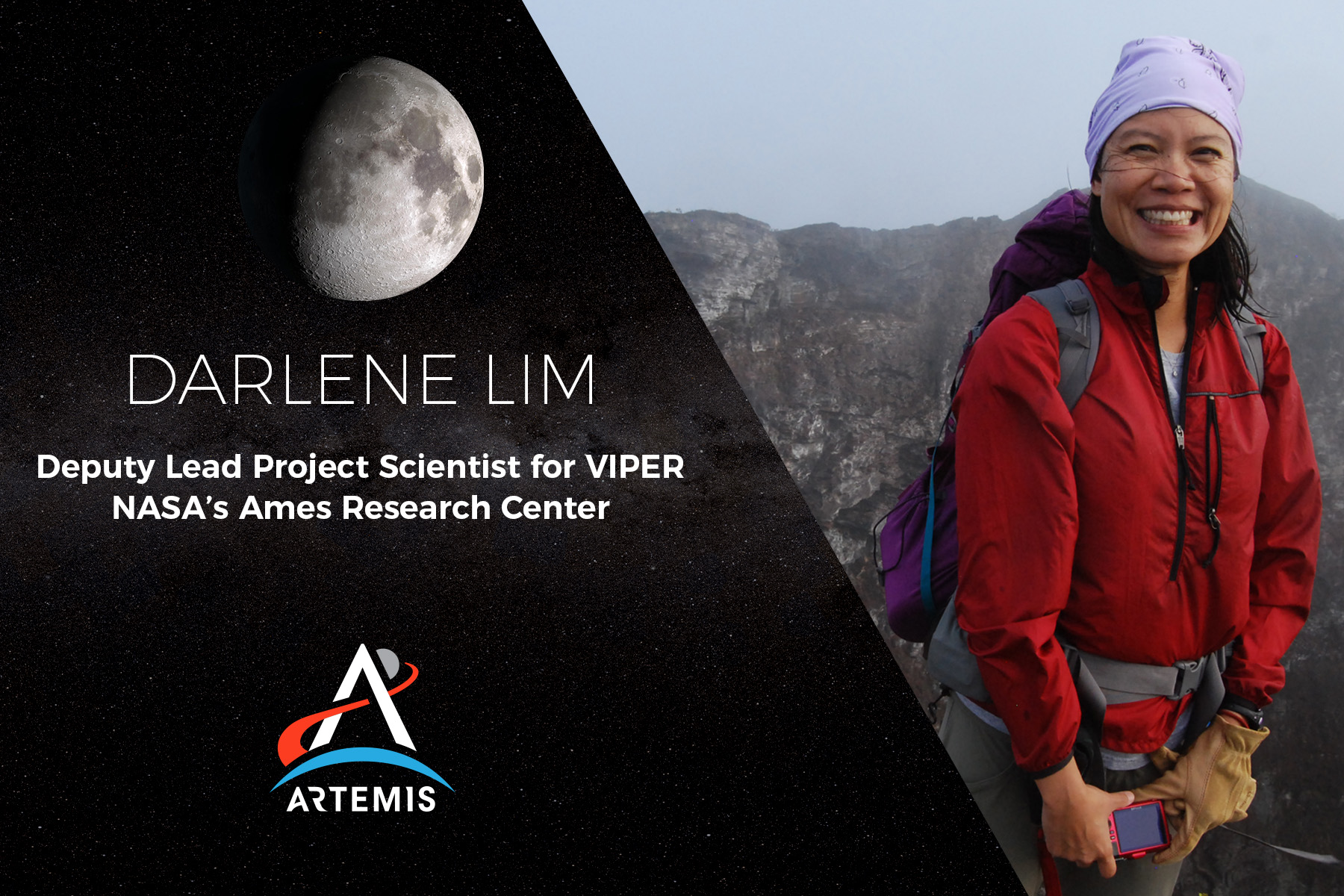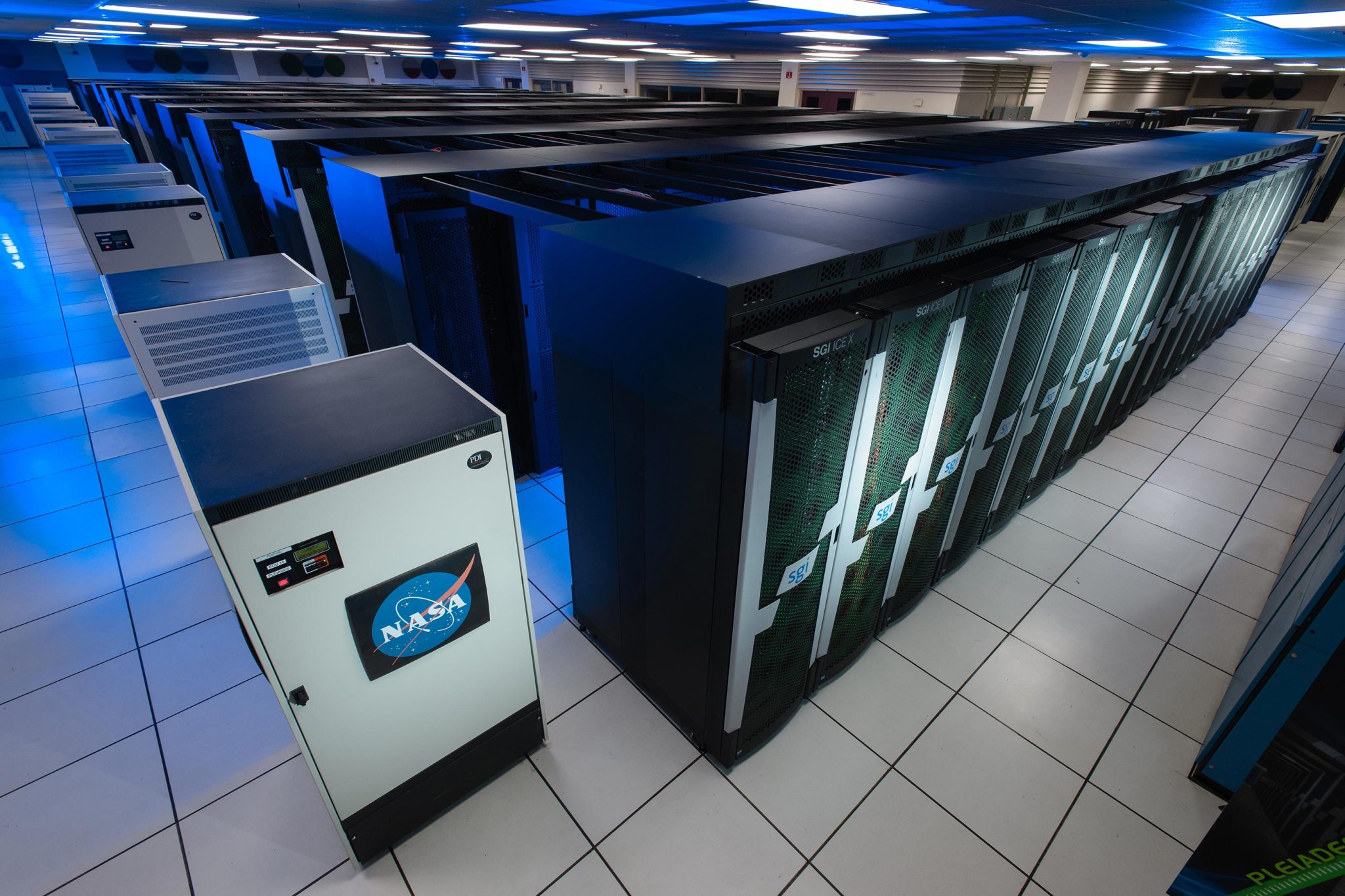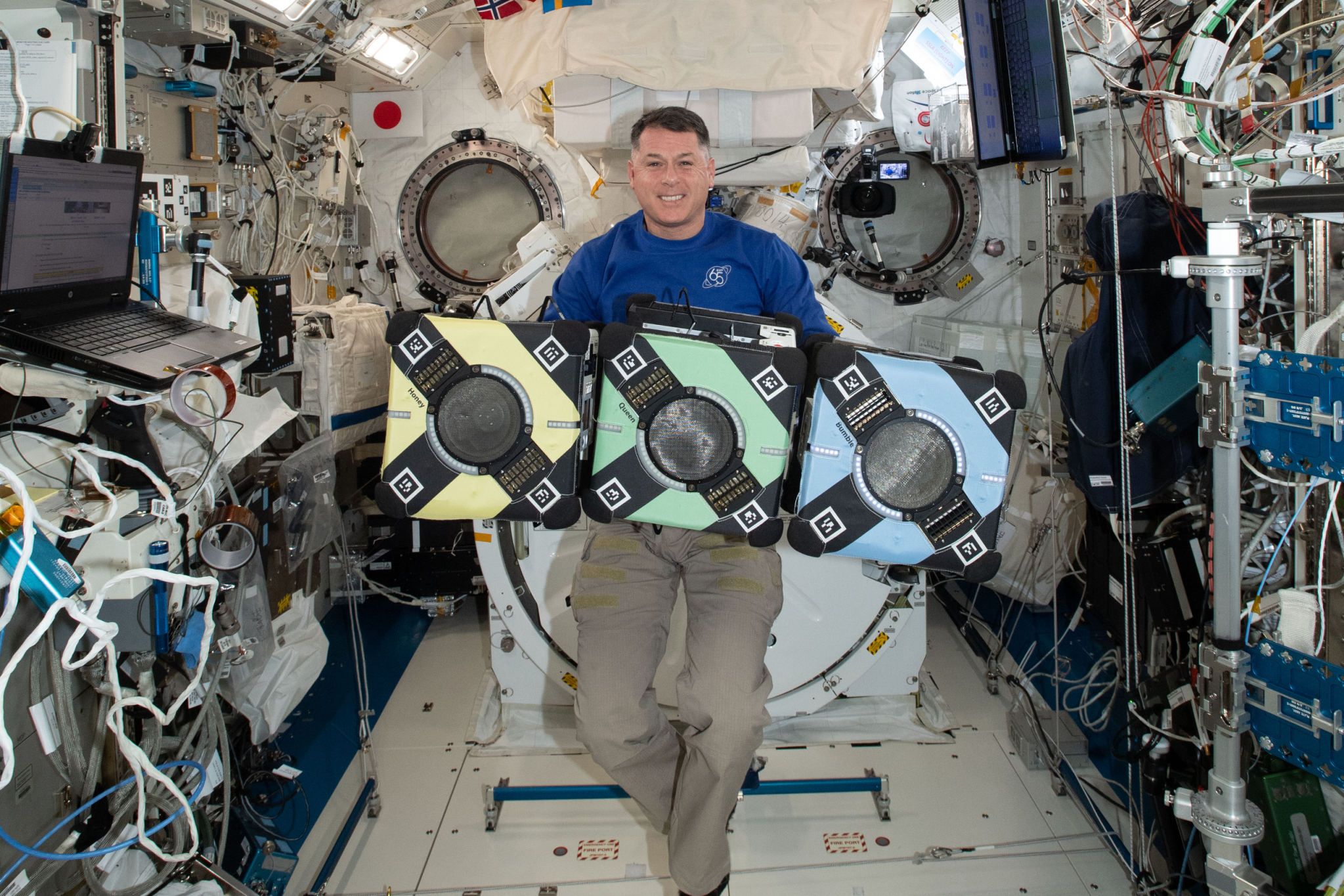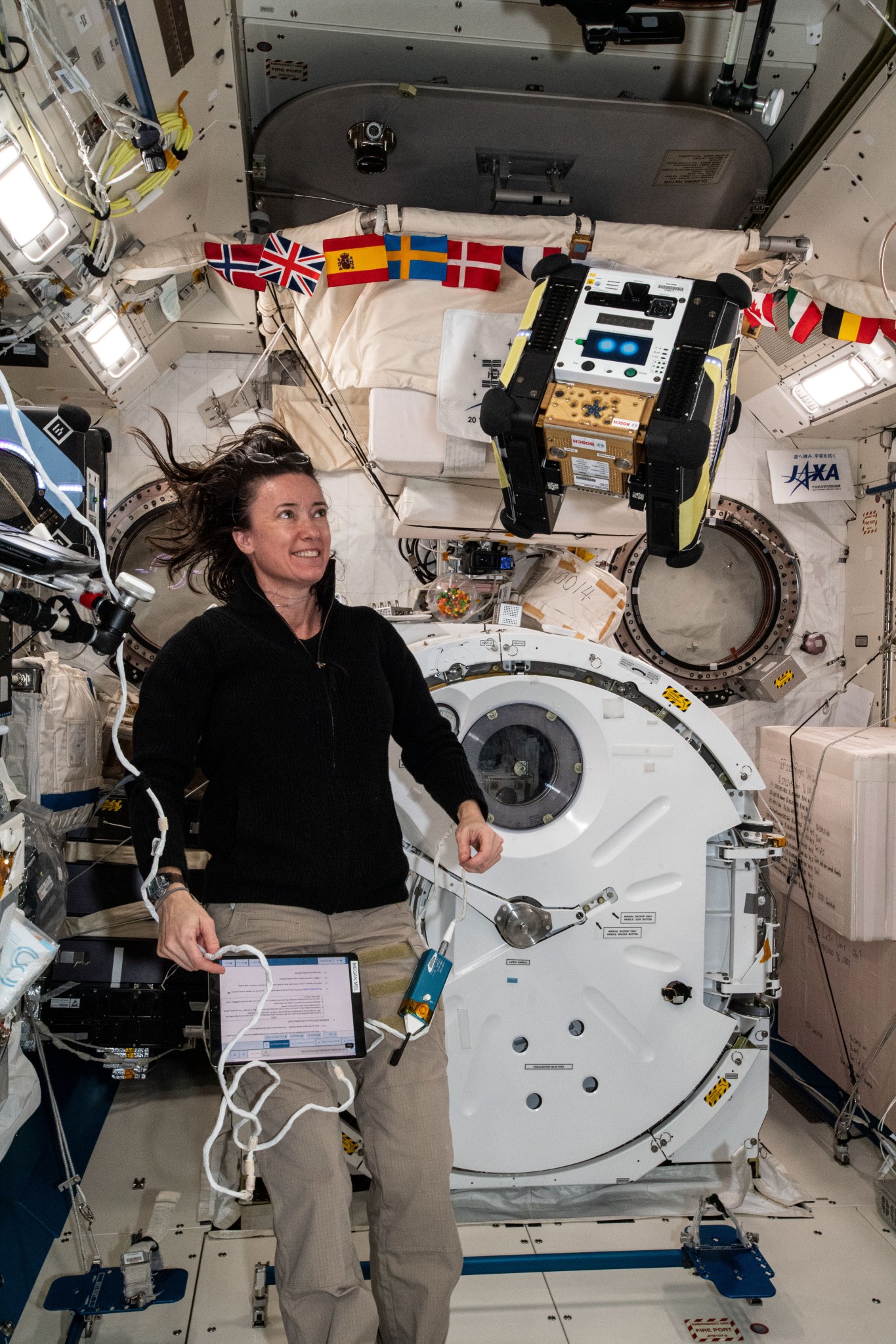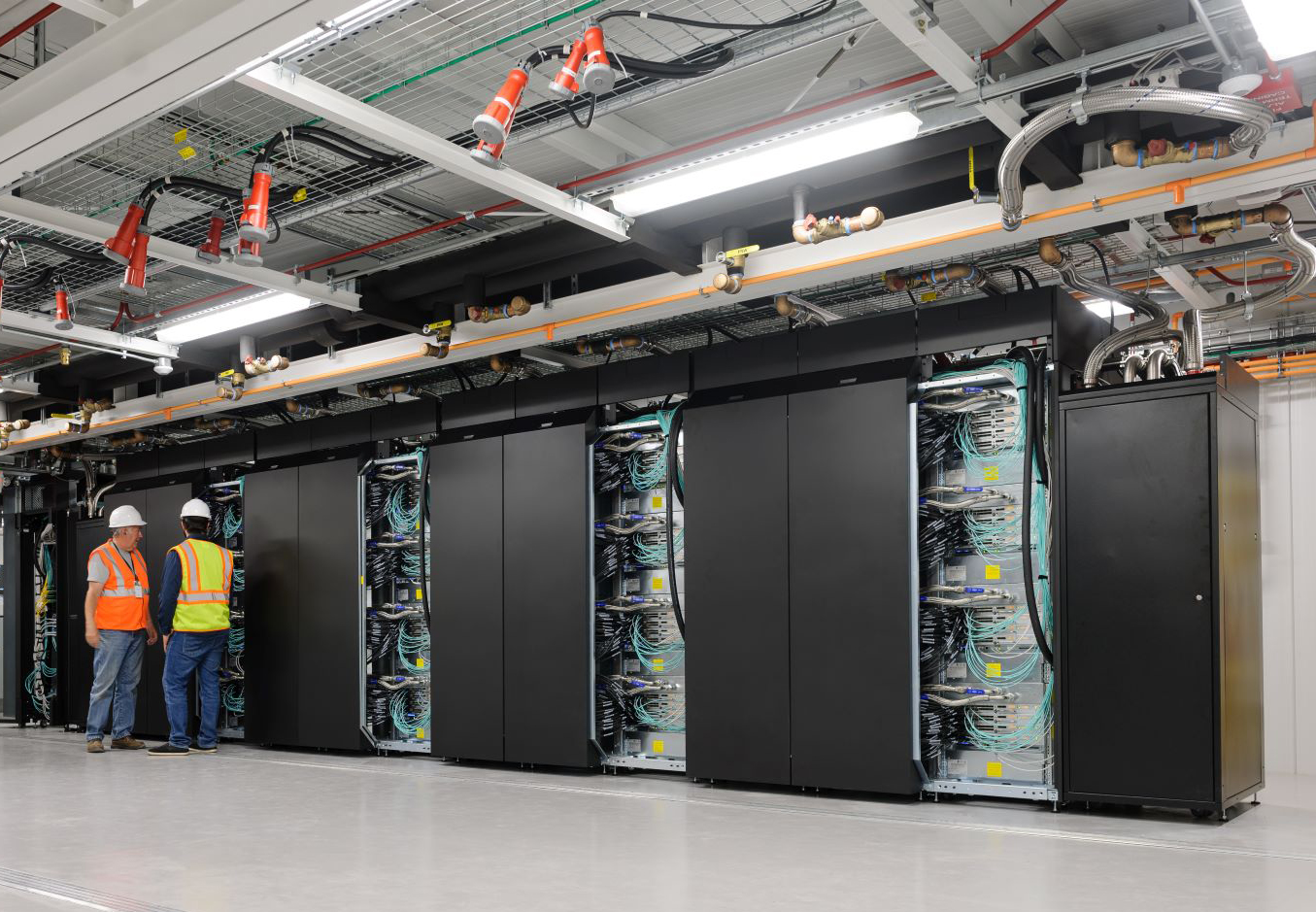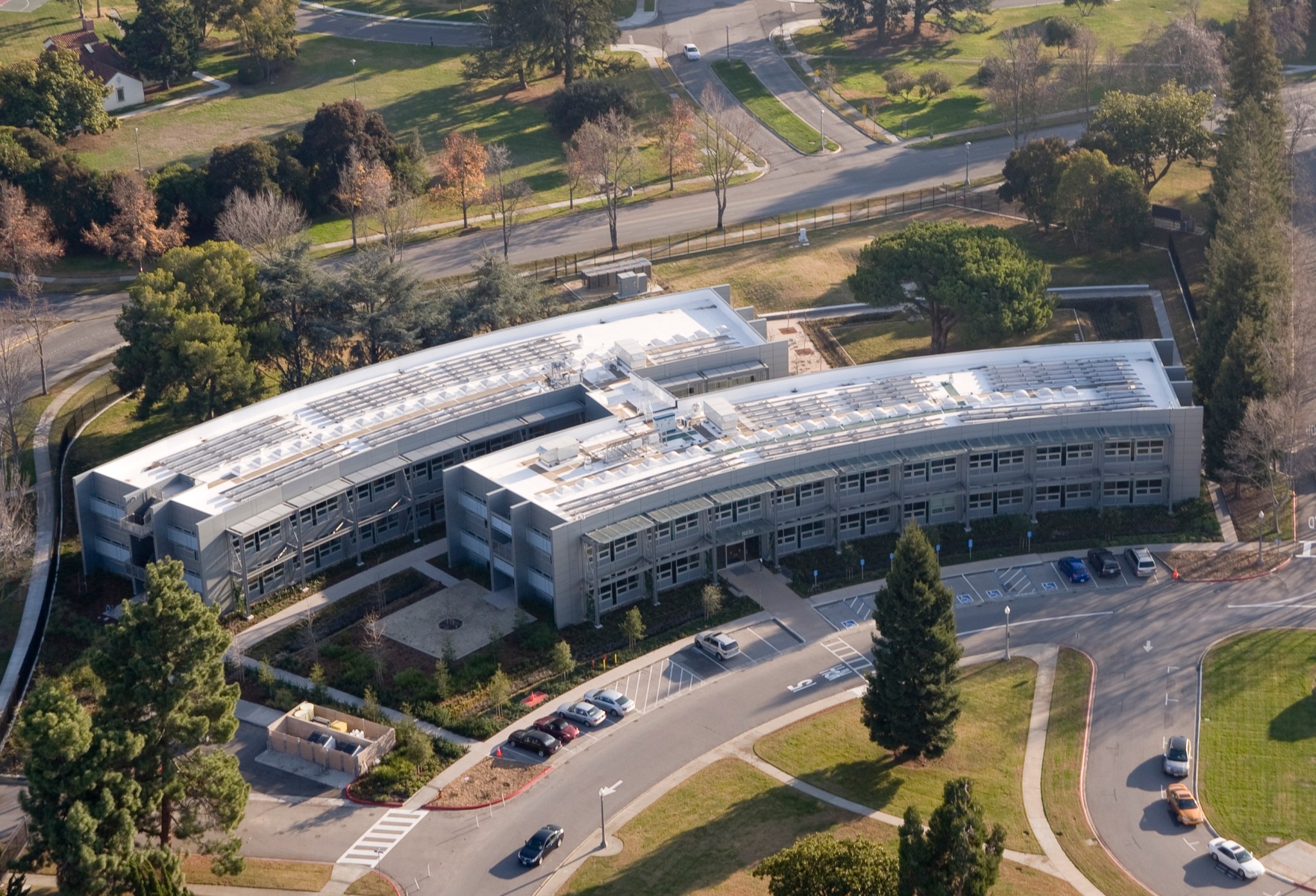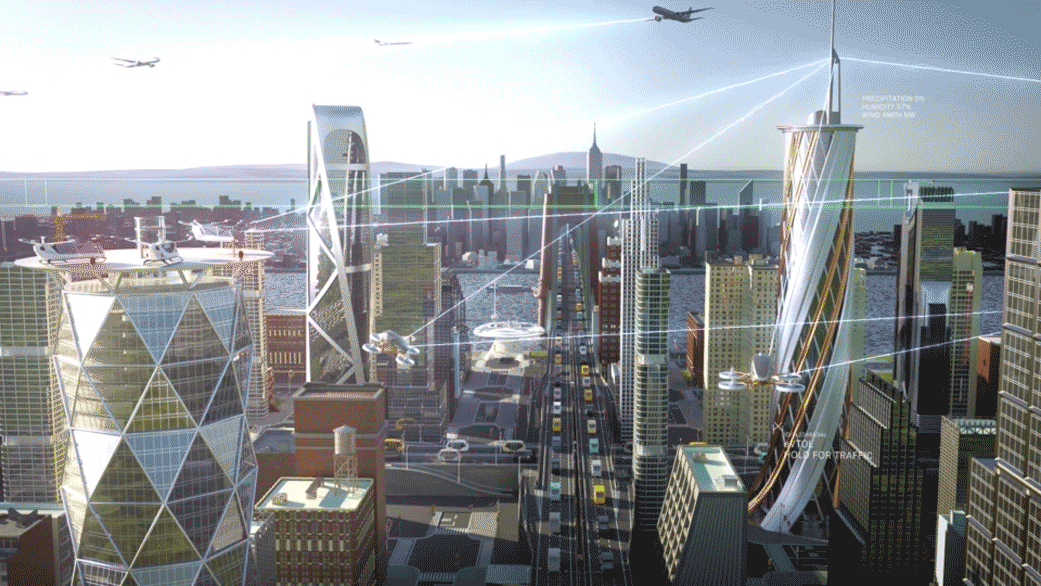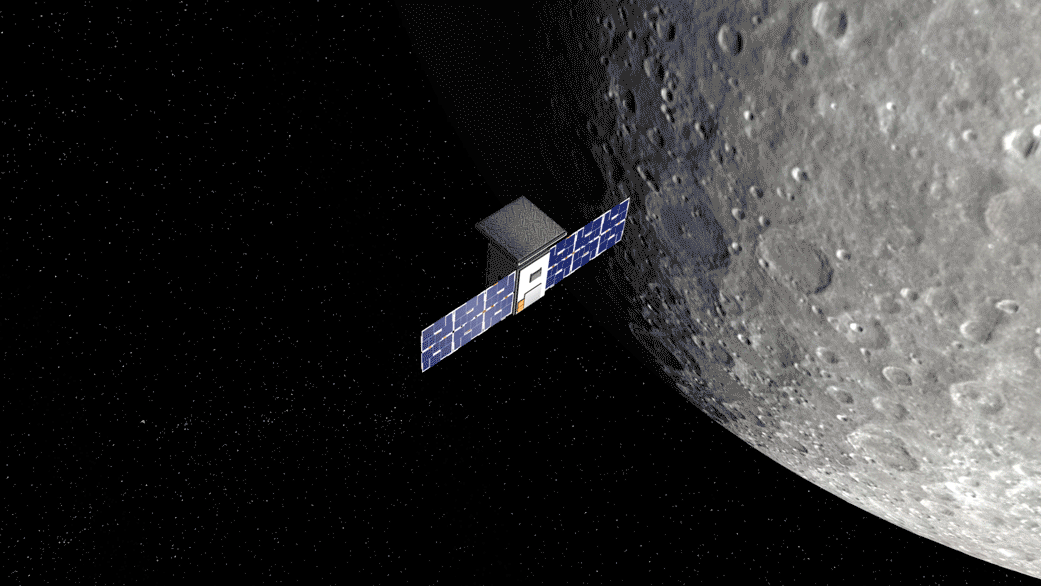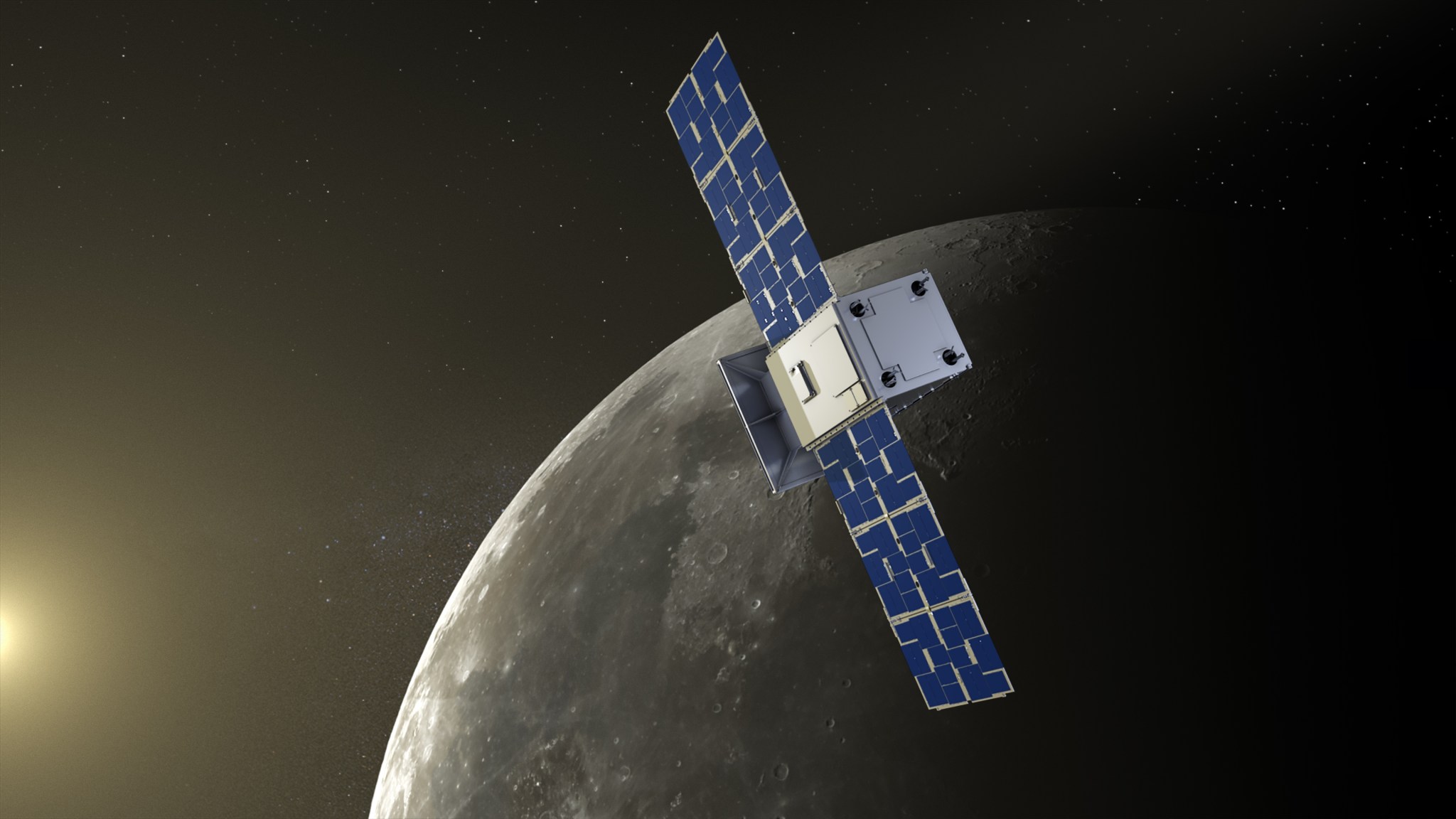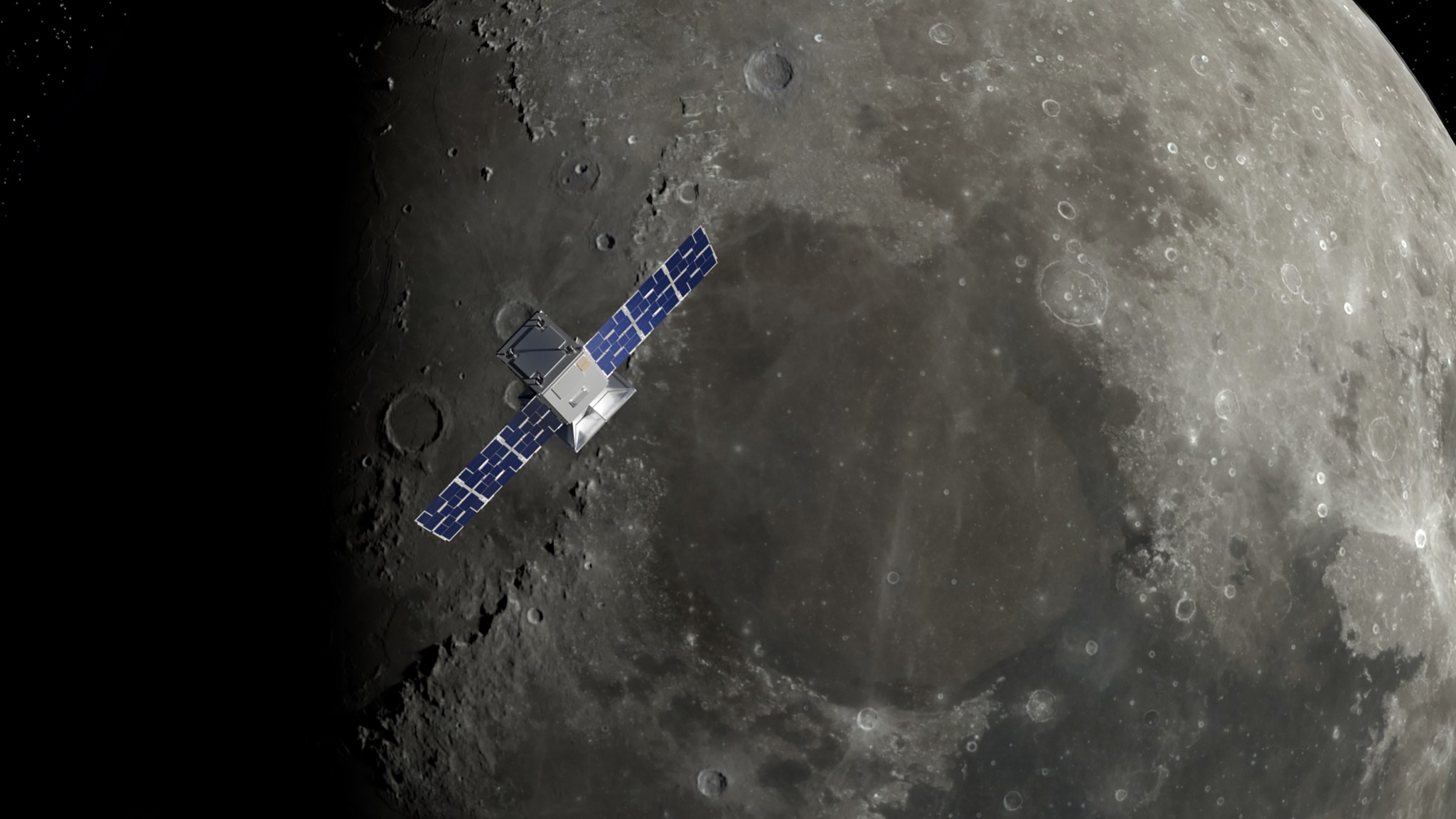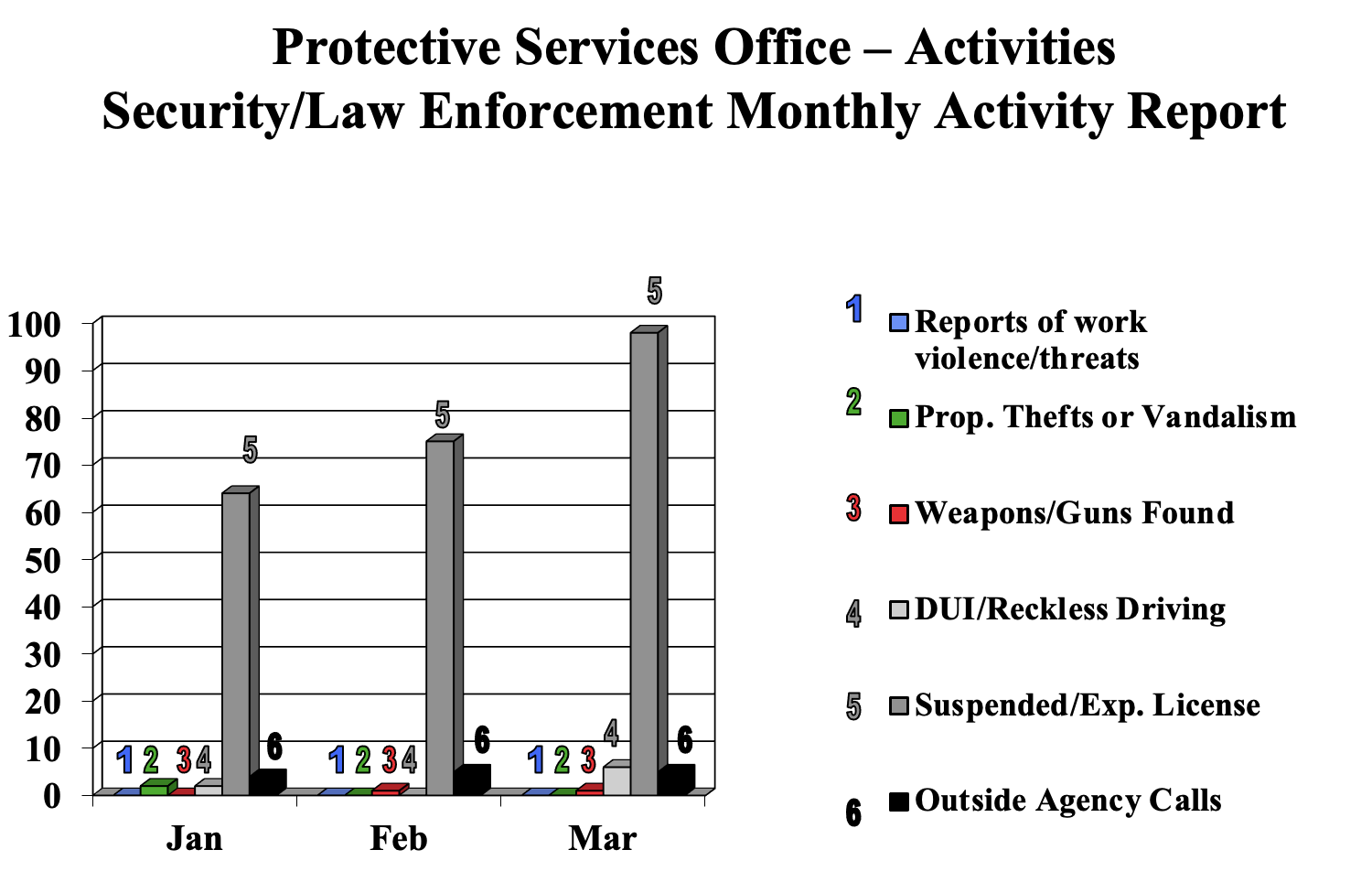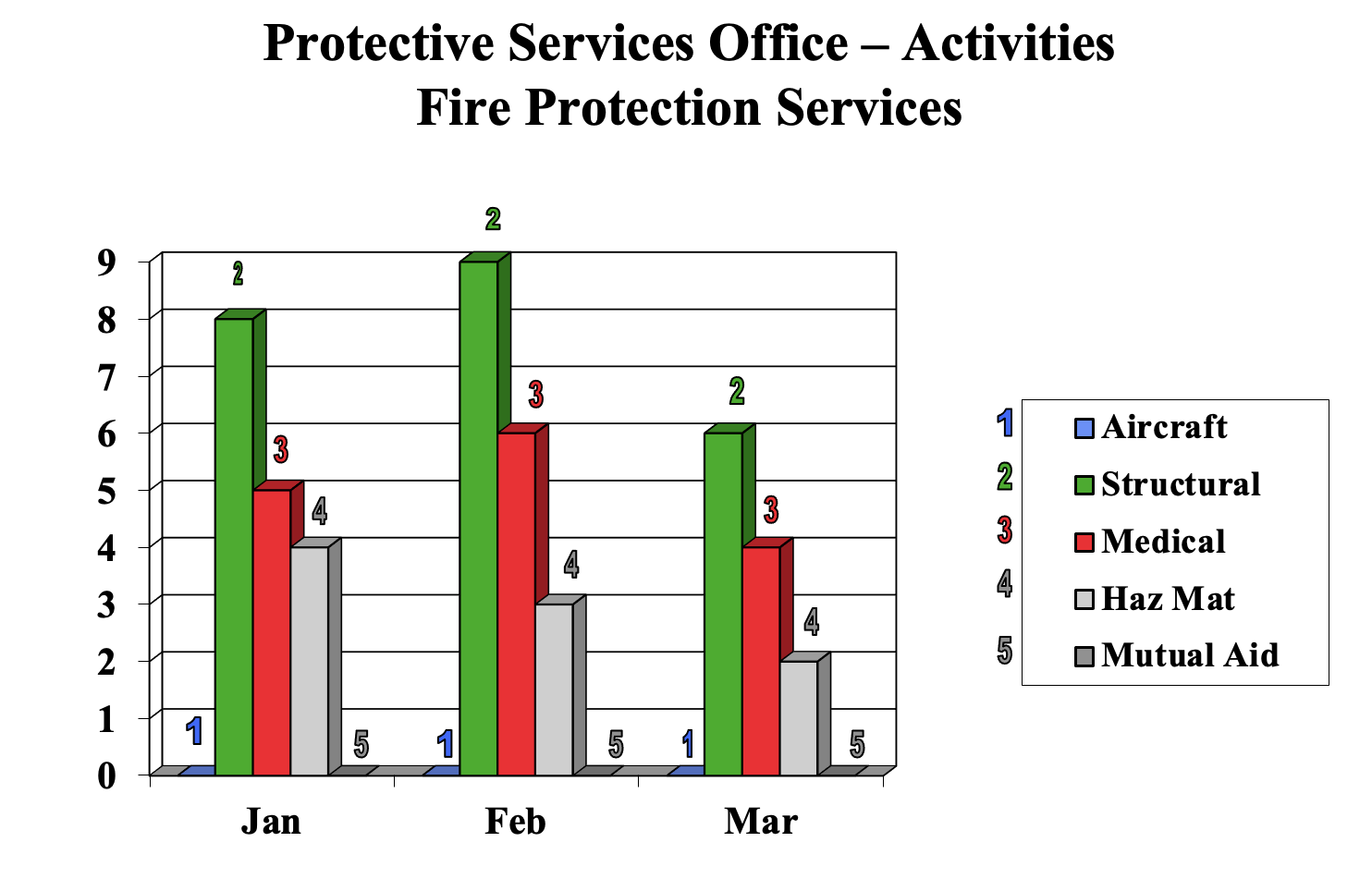NASA’s CAPSTONE Prepares to Enter Unique Orbit
by Frank Tavares
The pathfinder for NASA’s lunar outpost will launch in May to test an orbit around the Moon that has never been flown before. The Cislunar Autonomous Positioning System Technology Operations and Navigation Experiment (CAPSTONE) is undergoing final construction – and with solar panel installation and vibration testing now complete, the small satellite will soon be shipped to its launch location in New Zealand.
CAPSTONE – operated by Advanced Space – will help pave the way for NASA’s future exploration of the solar system, testing out this significantly elongated and halo-shaped orbit before arrival of Gateway, a next-generation space station that will provide access to the Moon and potentially beyond. Like Gateway, CAPSTONE continues the tradition of commercial partnerships, with five companies, including American small businesses, making contributions. The spacecraft was built and tested by Tyvak Nano-Satellite Systems, Inc., a Terran Orbital Corporation in Irvine, California, and will be launched by Rocket Lab of Long Beach, California.
Some of those partners are joining members of the CAPSTONE team at this year’s Space Symposium, sharing the project’s work and celebrating the induction of small satellite technologies into the Space Technology Hall of Fame. Small satellites, including CubeSats like CAPSTONE, can make meaningful contributions to science and exploration at a lower cost and faster cadence.
The CAPSTONE mission sends a CubeSat – about the size of a microwave oven – to study this orbit for at least six months, launching via a trajectory known as a ballistic lunar transfer. This highly efficient trajectory uses very little fuel, making use of the Sun’s gravity to reach this unique orbit around the Moon.
By taking advantage of the precise points between the Earth and Moon where the gravity from both is balanced out, spacecraft traveling along this orbital path can save energy to maintain the orbit. It also takes less fuel to enter the orbit because of its elongated shape, only 1,000 miles away from the North Pole at its nearest pass to Earth every six and a half days.
During its journey along this path, CAPSTONE will test out spacecraft-to-spacecraft navigation and communications systems with NASA’s Lunar Reconnaissance Orbiter, another spacecraft in orbit around the Moon. By demonstrating that two orbiting spacecraft can communicate and track their positions independent of Earth, NASA is showing how future missions could pinpoint their place in space as they reach for more distant destinations.
Now that testing is completed, CAPSTONE is on track to launch next month and begin testing the path that NASA’s Gateway will follow in the years to come
CAPSTONE is commercially owned and operated by Advanced Space in Westminster, Colorado. It represents an innovative collaboration between NASA and industry to provide rapid results and feedback to inform future exploration and science missions.
NASA’s Small Spacecraft Technology program within the agency’s Space Technology Mission Directorate (STMD) funds the demonstration mission. The program is based at NASA’s Ames Research Center in California’s Silicon Valley. The development of CAPSTONE’s navigation technology is supported by NASA’s Small Business Innovation Research and Small Business Technology Transfer (SBIR/STTR) program, also within STMD. Advanced Exploration Systems within NASA’s Exploration Systems Development Mission Directorate funds the launch and supports mission operations. The Launch Services Program at NASA’s Kennedy Space Center in Florida manages the launch.
Hangar One Restoration Project
A historic landmark in the San Francisco Bay Area, and a part of the region’s early aviation history, is being restored.
by Rachel Hoover
Engineers are about to undertake a massive restoration effort of this iconic landmark. After the remediation, clean-up, and restoration work is complete, Hangar One – now 90 years old – will be closer than ever to reuse.
Years ago, the Navy removed all the hangar’s roof, siding, windows, doors, and other materials, which were contaminated with toxic chemicals. The Navy then sealed the hangar’s structural frame with epoxy to ensure the chemicals would not pose a health risk, leaving it intact until further work could be completed.
Now the task of removing the remaining toxic chemicals from the hangar begins. First, working section by section, areas of Hangar One will be surrounded with scaffolding and encased to keep materials inside. Only then will the contaminated materials be carefully removed and stored in the vicinity of the hangar until they can be taken off-site for proper disposal. After the contaminated materials are removed, the steel frame will be primed and repainted to protect it from the elements until adding siding, windows, and doors can begin.
As each section is complete, several structural upgrades will also be made – to ensure the enormous hangar is seismically stable, for example – as well as other mechanical, plumbing, electric, landscape, and hardscape improvements.
The cleaning, repainting, and upgrades to the entire hangar are scheduled to be completed by 2025. Once Hangar One is fully restored, engineers plan for it to resemble, as closely as possible, its original visual characteristics.
Milestones:
- March 2022: Scaffolding and encasement around Hangar One begins.
- Spring 2022: Removal and disposal of contaminated materials begins.
- Summer 2022: Repainting of steel frame in the first work area begins.
- 2022-2025: Work continues in remaining work areas.
- 2025: Last of the scaffolding and encasement around final work areas is removed.
Timeline:
- 1933: The United States Navy built Hangar One at Naval Air Station Sunnyvale for the USS Macon airship and to serve as the West Coast base for the U.S. lighter-than-air aviation program.
- 1935: After the destruction of the dirigible U.S.S. Macon, Hangar One and all of Naval Air Station Sunnyvale was transferred to the U.S. Army, renamed Moffett Field Army Air Corps Base, and was used to house training aircraft.
- 1942: Moffett Field Army Air Corps Base was transferred back to the U.S. Navy and re-commissioned as Naval Air Station Moffett Field.
- 1994: The Navy transferred the hangar to NASA after Moffett Field was decommissioned.
- 1997: During routine stormwater testing, NASA discovered a toxin called polychlorinated biphenyls, or PCBs, specifically Aroclor 1260 and 1268, and other contaminants in the Center’s storm drain settling basin.
- 2002: Sampling programs determine that the composite corrugated material used to make the original external siding of Hangar One was the source of the PCBs as well as asbestos and the paint used to cover both the siding and steel frame of Hangar One contained lead and PCBs.
- 2003: An inspection reveals PCBs, and other contaminants are leaking from the hangar’s metallic exterior. As a result of the high levels of PCBs present in the Hangar One building components, the hangar was closed to human use, as required by the Toxic Substances Control Act.
- 2008: At a Navy public hearing, members of the local community expressed overwhelming support for full restoration of Hangar One.
- June 2010 – June 2013: The Navy addressed contamination at Hangar One by preserving and decontaminating historic artifacts; removing the hangar’s roof, siding, windows, doors, and other exterior components; demolishing the interior structures of the hangar; coating the structure with epoxy; among other activities.
- May 28, 2013: NASA and the U.S. General Services Administration issued a Request for Proposals to obtain lease proposals for the rehabilitation and adaptive reuse of Hangar One, and for the operation, management, and maintenance of Moffett Federal Airfield.
- February 2014: After a fair and open competition, the U.S. General Services Administration and NASA selected Planetary Ventures, LLC as the preferred lessee and began lease negotiations to manage Moffett Federal Airfield and rehabilitate historic Hangar One.
- Jan. 14, 2020: Engineering Evaluation/Cost Analysis (EE/CA) is approved by the U.S. Environmental Protection Agency (EPA) and the California Regional Water Quality Control Board (Regional Water Board).
- Nov. 17, 2020: Action Memorandum is approved by the EPA.
- Nov. 18, 2020: Action Memorandum is approved by the Regional Water Board.
- Feb. 3, 2022: Non-Time-Critical Removal Action (NTCRA) Work Plan is submitted to the EPA and the Regional Water Board.
- March 24, 2022: EPA and the Regional Water Board approved the Final Non-Time-Critical Removal Action Work Plan
Fast Facts:
- Hangar One is a very large structure measuring approximately 1,133 feet long, 308 feet wide, and 198 feet high.
- Hangar One is in the Shenandoah Plaza Historic District, which is listed in the National Register of Historic Places at the National level of significance under
- Criterion A for the association with coastal defense and naval technology that has made a significant contribution to the broad patterns of our history; and
- Criterion C reflecting the distinctive type, period, method of construction and high artistic values that are represented in the 1933 station plan and buildings.
- Hangar One is designated as a Naval Historical Monument as well as a California Historic Civil Engineering Landmark by the San Francisco section of the American Society of Civil Engineers.
Collaborators:
- Planetary Ventures, LLC of Delaware
Learn more:
- NASA story: Second Life for Historic Hangar One Wood: Super Bowl 50 Stadium Décor (Feb. 1, 2016)
- NASA video: Second Life for Hangar One Wood (Feb. 3, 2016)
- NASA release: NASA Signs Lease with Planetary Ventures LLC for Use of Moffett Airfield and Restoration of Hangar One (Nov. 10, 2014)
NASA-Supported University Research Slated for Upcoming CubeSat Missions
by Sonja Caldwell
Expanding the capabilities of small spacecraft as critical platforms for research and technology demonstrations, the agency’s SmallSat Technology Partnerships (STP) initiative is funding university research with the potential to advance the small spacecraft industry and support lunar and deep space missions. Under cooperative agreements managed by NASA’s Small Spacecraft Technology (SST) program, Utah State University in Logan and Stanford University in California will test research payloads on several CubeSat missions planned for launch as early as 2022.
“We are driving innovative small spacecraft research that shows promise for widespread adoption by industry, as well as the advancement of space exploration and science goals,” said Roger Hunter, SST program manager at NASA’s Ames Research Center in California’s Silicon Valley. “This is core to our program’s mission.”
Keeping Instruments Cool
Building on earlier support from STP, Utah State University will soon test their active thermal architectures (ATA) technology in space to address the challenge of heat buildup in spacecraft. The team aims to improve the use of CubeSats for carrying cryogenic instruments into orbit for tasks like measuring the heat that collects in Earth’s upper atmosphere. Unfortunately, those instruments tend to overheat.
“Currently, we can only run cryogenic instruments in space very briefly before they get really hot, and we have to turn them off and cool them down before trying again,” said Charles Swenson, principal investigator for ATA and professor of electrical and computer engineering at Utah State University.
To address this issue, the team created a thermal control technology based on a miniaturized pumped fluid loop that transports coolant from one part of a spacecraft to another. Using 3D-printed flow channels, micropumps, and a cyro-cooler refrigeration unit, the ATA can fit in a 5 centimeter x 10 centimeter x 10 centimeter (approximately 2 inch x 4 inch x 4 inch) space inside a six-unit CubeSat. Like a radiator fluid pump in car engines, the device collects and ultimately ejects heat by pumping fluid through a radiator.
“Additive manufacturing lets us miniaturize the fluid channels, which can be embedded directly into the CubeSat frame,” noted co-investigator and Utah State doctoral student Lucas Anderson. The team also developed a miniature rotating fluid joint that uses a motor to turn and allow for the flow of fluid to the radiator. Utah State’s will be the first hardware of its kind to fly on a small satellite. The joint enables the radiator to point away from the Sun and radiate heat into deep space, enabling the instruments to operate at ideal temperatures.
The ATA project will fly as a collaborative mission with an infrared electro-optical cryogenic instrument developed with the University of Hawaii in Honolulu. Both payloads will fly on NASA’s Earth Science Technology Office’s Active Cooling for Multispectral Earth Sensors (ACMES) mission as part of NASA’s CubeSat Launch Initiative (CSLI), planned for mid-2024.
Enabling SmallSat Swarms
A Stanford University initiative with two STP awards is also planned for upcoming launch. The team is researching distributed autonomous small spacecraft technology, designed to ensure robust and accurate navigation of swarms of satellites. This has several applications in Earth and planetary science, astronomy and heliophysics, space situational awareness, and in-orbit servicing.
Low-Earth orbit satellites currently rely on global positioning system (GPS) signals to maintain orbit, but as spacecraft venture deeper into space, they go out of GPS range. Stanford has developed optical navigation algorithms that leverage imagery of a target body, planet, or vehicle so SmallSats can identify and track each other to determine their absolute orbits – the location of the spacecraft relative to a planetary body – without depending on GPS. This technique is designed to allow for swarms of small spacecraft to maintain formation and execute maneuvers. Besides autonomous navigation in deep space, the technology could help identify, track, and determine the orbits of thousands of defunct satellites orbiting Earth.
“Characterizing a piece of debris using multiple spacecraft is more accurate than what you can do with a single spacecraft,” said Simone D’Amico, Stanford associate professor of aeronautics and astronautics and principal investigator for the STP-supported technology. He compares these spacecraft clusters to a flock of birds flying in formation. Like a flock, the swarm can extend its reach and perform tasks impossible by a single entity. In the case of spacecraft swarms, that means capturing richer imaging over a larger area and from multiple directions.
Stanford’s STP-supported autonomous and distributed navigation technologies are slated for three different upcoming CubeSat swarm missions, starting with NASA’s Starling multi-CubeSat technology demonstration scheduled for launch in mid-2022. The six-month mission will use four CubeSats that will perform inter-satellite optical measurements of each other and nearby stars to estimate their absolute orbits without GPS. The other demonstrations – Virtual Super-resolution Optics with Reconfigurable Swarms (VISORS) and the Space Weather Atmospheric Reconfigurable Multiscale Experiment (SWARM-EX) – are planned for launch in late 2023 as part of NASA’s CSLI.
Stanford Ph.D. student Justin Kruger reflected, “Working on the project has been incredibly rewarding, not only in pushing the envelope for future multi-spacecraft systems, but also in getting to experience first-hand just how much teamwork goes into making a mission happen.”
Learn more about the SmallSat Technology Partnerships Initiative:
https://www.nasa.gov/directorates/spacetech/small_spacecraft/smallsat-technology-partnership-initiative/
About NASA’s Small Spacecraft Technology Program
The Small Spacecraft Technology program, part of NASA’s Space Technology Mission Directorate, expands the ability to execute unique missions through rapid development and demonstration of capabilities for small spacecraft applicable to exploration, science, and the commercial space sector. SST-funded projects may be executed at academic institutions, in the private sector, at NASA centers, as public-private partnerships, or cooperative agreements. The program office resides at NASA Ames.
NASA Tries New Ways, Fluid Materials to Build Giant Space Telescopes
by Rachel Hoover
When it comes to telescopes, bigger is better. Larger telescopes collect more light and allow astronomers to peer farther into space and see distant objects in greater detail.
What if there was a way to make a telescope 10 times – or even 100 times – bigger than before? What started as a theoretical question is now a series of experiments to see if fluids can be used to create lenses in microgravity. The next experiment is stowed on the International Space Station National Laboratory waiting for the arrival of Axiom-1 astronauts to try it out, and is part of Ax-1 Mission Specialist Eytan Stibbe’s research portfolio.
It Starts with Fluids
All liquids have an elastic-like force that holds them together at their surface. This force is called surface tension. It’s what allows some insects to glide across water without sinking and gives water droplets their shape. On Earth, when droplets of water are small enough (2 mm or smaller), surface tension overcomes gravity and they remain perfectly spherical. If a droplet grows much larger, it gets squished under its own weight.
But in space, blobs of water and other liquids (after wobbling about) eventually assume a perfect spherical shape.
Edward Balaban, principal investigator of the Fluidic Telescope Experiment, or FLUTE, at NASA’s Ames Research Center in California’s Silicon Valley teamed up with researchers at Ames, the agency’s Goddard Space Flight Center in Greenbelt, Maryland, and Technion – Israel Institute of Technology, to explore whether it was possible to make high-precision lenses and mirrors in space using liquids.
“We thought, why not take advantage of the way liquids naturally behave in microgravity and apply it to the construction of large-scale telescopes or space-manufactured optical components that can have all kinds of uses,” said Balaban. “In microgravity, liquids take on shapes that are useful for making lenses and mirrors, so if we make them in space, they could be used to build telescopes that are dramatically bigger than was previously thought possible.”
Ground Tests: A Drop in the Bucket
Before taking their ideas to the skies, the team wanted to test their ideas on the ground.
“Liquids are useful not only for creating the lenses themselves, but also as a mechanism to eliminate the effect of gravity in an experiment on Earth,” said Moran Bercovici, an associate professor of Mechanical Engineering at Technion.
“By injecting a liquid that can be solidified, into circular frames submerged in water, we were able to create lenses literally in a janitor’s bucket,” said Dr. Valeri Frumkin, who developed the method in Bercovici’s group. “Polymers, which are also used in nail salons to make acrylic nails or in adhesives like superglue, are a natural choice for lens material. The trick is to make sure that the water has the exact same density as the polymer we’re injecting so that the forces of buoyancy precisely oppose gravitational forces to simulate the conditions of weightlessness.”
The resulting lenses have an outstanding surface quality comparable or even better than achievable with the best polishing methods, and they took only a tiny fraction of the time to construct.
“This method allows us to completely skip any mechanical processes such as grinding or polishing,” said Bercovici. “The natural physics of fluids simply does all the work for us.”
Next Up: Testing in Microgravity
In December 2021, the team tried out their ideas on two ZeroG parabolic flights. The flights provided 50 opportunities to achieve 15 to 20-second periods of microgravity – long enough for the team to form liquid lenses and capture data to analyze whether they achieved their goals.
During the flight researchers used pumps to push synthetic oil into a circular frame (about the size of a dollar coin), letting the liquid fill the gap and momentarily achieve the desired shape. The oils are similar to automotive oil, with different levels of viscosities – or goopiness – to try out which works better.
“Sure enough, in a few seconds we were able to create a free-standing liquid lens – until the plane lifted upwards again and gravity kicked in and the oils oozed out,” said
Bercovici. “Our experiment on the space station will add a step to cure the fluids so they keep their shape.”
Using a laser to take ultra-fast and ultra-exact measurements, they were able to see the precise moment the liquid took shape.
With the first round of parabolic flights successfully behind them, the team eagerly awaits their experiment aboard the orbiting laboratory. Ax-1 crew member Eytan Stibbe will perform the experiment and former NASA astronaut and Ax-1 commander Michael Lopez-Alegria will serve as his backup. The experiment will take place entirely in microgravity, again using liquid polymers (like the hardened lenses made in the lab at Technion) and will use either UV light or temperature to harden them in-orbit. The lenses will then return to Earth where researchers at Ames will study them.
“We expect this approach will create perfectly shaped and smooth surfaces: the best surfaces to turn into mirrors,” said Vivek Dwivedi, a FLUTE scientist at Goddard and expert in atomic layer deposition technology that could be used to make ultra-precise telescope mirrors in space.
“If our station experiment is successful, it will be the first time an optical component is made in space,” said Balaban. “It feels a bit like making history.”
The space station experiment is part of the Rakia Mission, led by The Ramon Foundation, and is supported by The Israeli Space Agency and the Israeli Ministry of Innovation, Science and Technology. NASA’s Space Technology Mission Directorate supports FLUTE through the Center Innovation Fund and the Flight Opportunities Program. FLUTE’s test aboard the space station is sponsored by the International Space Station National Laboratory.
I am Artemis: Darlene Lim
by Aimee Crane
You could say Darlene Lim is partial to the extremes – and always has been.
As a child growing up in Alberta, Canada, Darlene Lim learned early how to adapt to harsh temperatures and conditions.
“Being resilient is just a part of life there,” Lim said. “It can be very hard to live in that kind of environment without the right skills and preparation.”
Now, as the deputy lead project scientist for NASA’s Volatiles Investigating Polar Exploration Rover, or VIPER, at the agency’s Ames Research Center in California’s Silicon Valley, Lim has shaped her career around studying some of Earth’s most remote and challenging landscapes. Her field study findings help researchers better understand how to conduct science on other planetary bodies across our solar system, like the Moon and Mars.
VIPER will traverse the lunar South Pole in late 2023 to search for ice and other potential resources that could be harvested to enable long-term human exploration of the Moon and deep space through NASA’s Artemis missions.
During the 100-day scouting mission around the Moon’s Nobile Crater, VIPER will navigate difficult terrain and endure extraordinary temperatures and lighting – familiar conditions for Lim.
“NASA’s VIPER mission is a very exciting opportunity to explore and study the lunar South Pole including below the surface,” Lim explained. “I see my role as enabling the scientists in this unique, first-time operational environment.
VIPER will analyze ice deposits at various depths beneath the lunar surface in real time. The data VIPER sends back to Earth will help us understand how water is created and moves around on the Moon and across the solar system. Data will also be used to create resource maps to help guide decisions about where and how to explore during future Artemis missions.
“I see Artemis as a hopeful endeavor,” Lim said. “It allows us to construct a future for human exploration that is inclusive, and representative of humanity.”
The VIPER mission is managed out of NASA’s Ames Research Center in California’s Silicon Valley, and is scheduled to be delivered to the Moon in late 2023 by Astrobotic’s Griffin lander as part of the Commercial Lunar Payload Services initiative. Construction of the rover will begin in late 2022 at NASA’s Johnson Space Center in Houston, while the rover flight software and navigation system design will take place at NASA Ames. Astrobotic will receive the complete rover with its scientific instruments in mid-2023 in preparation for launch later that year.
NASA Mentors Students to Achieve High Performance in Supercomputing Competition
by Abigail Tabor
Talented students from communities around the U.S. recently gained hands-on experience in high-performance computing, NASA style. With help from experts in the NASA Advanced Supercomputing (NAS) division at the agency’s Ames Research Center in California’s Silicon Valley, the students took part in a supercomputing competition. Twelve teams of undergraduate and graduate students from six Historically Black Colleges and Universities and four Hispanic Serving Institutions participated in the second annual Winter Classic Invitational Student Cluster Competition.
The competition is a win-win for the students and for NASA: it provides students with firsthand practice in developing skills to prepare them for positions in high-performance computing (HPC) and gives NASA an opportunity to attract the next generation of HPC professionals.
NASA was one of four mentor institutions who took turns hosting the students virtually. During the week-long NASA round of the competition, which ended on March 12, the teams were guided by NASA computing pros who specialize in optimizing codes to make them run more effectively and quickly. The students ran their computational jobs on Ames’ powerful Pleiades supercomputer, comprised of a cluster of computer nodes connected together to work as a single system. Pleiades is used by scientists and engineers around the world to help solve some of NASA’s most challenging problems in the shortest time possible.
“The students worked really hard throughout the week and all of our preparation work paid off as we watched them inch toward achieving their best performance,” said Sherry Chang, an applications expert in the NAS division at Ames and one of the mentors who guided students through their competition tasks. “This event turned out to be quite rewarding, not just for the students but also for us mentors.”
In the months leading up to the workshop, the NAS division’s user support and applications experts got the students set up with everything needed to run their jobs on Pleiades, created training material, and held Q&A sessions to help them get started. The mentors offered advice and encouragement throughout the competition week, all of which paid off for the students.
“Thank you, everyone, for all the mentoring and help as we further our understanding in high-performance computing applications. I feel like I know a lot more now than prior to the start of this event,” said Alberto De La Rosa, a student participant from the University of Texas El Paso.
The 12 teams worked on a problem related to evaluating the performance of parallel supercomputers that run simulations for designing safe and efficient airplanes and spacecraft. Using modern cluster computers such as Pleiades, a problem of interest can be divided into smaller tasks. These tasks – such as for simulating airflow over a new aircraft design – can be simulated separately but simultaneously across the supercomputing cluster, allowing the computations to be done much faster.
“We were very pleased when NASA signed up as mentors for the 2022 Winter Classic, and after observing the training that NASA conducted with the students and seeing how much the students learned from this module of the competition, we were ecstatic,” said Dan Olds, chief research officer with Intersect360 Research, who organized the event. “The mentoring that NASA provided, along with access to a real-world supercomputer like Pleiades, really got the students thinking about building careers in HPC.”
After multiple rounds of competition, one member of each team was awarded the Brueckner Award Scholarship by Intersect360 Research. Plus, the winning team – from Tennessee State University, this year – received an HPC Jump Start Award of $10,000 to help fund the school’s HPC labs and resources.
This is the first year NASA is participating in the competition, supporting the collaboration with minority-serving institutions. The NAS Division staff represented NASA as one of four mentor HPC data centers supporting the competition, along with Oakridge National Laboratory, Amazon AWS, and Hewlett Packard Enterprise.
“It was a gratifying experience to mentor these highly motivated students and we hope to attract some of them to come and work with us,” said Piyush Mehrotra, chief of the NAS division at Ames. “We’re looking forward to being part of the competition again next year.”
The 12 NASA-mentored teams represented these six Historically Black Colleges and Universities and four Hispanic Serving Institutions:
- California State University Fullerton
- California State University Channel Islands (2 teams)
- Fayetteville State University
- Florida Agricultural and Mechanical University
- Morehouse College
- Prairie View A&M University
- Spelman College
- Tennessee State University
- Texas Tech University (2 teams)
- University of Texas El Paso
NASA Celebrates Three Years of Astrobees Buzzing on the Space Station
by Frank Tavares
Three years ago, a pair of robots were launched to the International Space Station to help pave the way for the future of robotics and autonomous systems in space. Those pioneers were Honey and Bumble, who were soon joined by a third companion called Queen, and together they make up the Astrobee free-flying robotic system. Robots like the Astrobees are essential components of NASA’s Artemis mission to deliver humans back to the Moon, before traveling to Mars and beyond.
“There’s a reason so many science fiction stories have a beloved robot alongside the human heroes – we know we can’t explore space alone,” said Jose Benavides, the Astrobee Facilities Project Manager at NASA’s Ames Research Center in California’s Silicon Valley. “We’re showing that humans and robotic systems can collaborate and support powerful science and engineering beyond Earth.”
Since launch, the Astrobee program – run out of NASA Ames – has operated over 750 hours on the space station, completing over 100 activities, from tech demonstrations to assisting in experiments. The robots have proven capable of feats previously in the realm of science fiction, such as detecting an anomaly during a simulation on station and connecting autonomously with station subsystems. Honey, Bumble, and Queen have been busy bees, and they show no signs of slowing down.
Three Years of Evolving Astrobees
The Astrobees are a next-generation technology, building upon three orb-shaped robots of the Synchronized Position Hold, Engage, Reorient, Experimental Satellite (SPHERES) project. Astrobees evolved from that initial concept as researchers developed new tools and capabilities.
They fly through microgravity using electric fans, they “see” using cameras and sensors, and they have arms to hold objects or keep steady for tasks requiring stability. Researchers have also tested an adhesive technology, inspired by gecko feet, to allow the Astrobees to grab onto a variety of surfaces without applying force to adhere and then detach on demand. The Astrobee teams envision a robotic system that’s smart and versatile enough to handle simpler maintenance and monitoring chores to leave astronauts free to tackle more complex work.
But the Astrobee platform isn’t just for astronauts. Through the annual Kibo Robot Programming Challenge, operated alongside the Japan Aerospace Exploration Agency (JAXA) and now in its third year, students from across the world can write code for the Astrobees. The winning teams get to see their programs run on the robots in space. Inspiring the next generation of programmers and engineers is vital as NASA prepares for a future where robotics will play a central role in humanity’s exploration beyond our planet.
Robotic Autonomy for Artemis and Beyond
Unlike the space station, future deep space outposts may not be crewed year-round, and will need autonomous systems to remain operational. That includes Gateway, which will orbit the Moon and serve as a launching-point for missions to Mars.
The Integrated System for Autonomous and Adaptive Caretaking project (ISAAC) aims to test how robotic systems can complete tasks like repairs, maintenance, and even experiments independently.
By giving Honey and Bumble challenges to solve on their own – like removing a “sock” blocking an air vent – ISAAC is building capabilities needed for robots to take care of spacecraft when astronauts aren’t aboard. But a major component of autonomously operating in a complex environment is being able to have a detailed map and know where you are.
ISAAC’s two most recent demonstrations used Astrobees to create 3D maps of the space station’s interior. Bumble flew out of its home module and mapped out a new environment on its own. The ability to explore and map independently is essential to the future of autonomous robotics.
“Three years ago, we wanted to test out how robotics could support human space exploration, not just for this decade, but for the next several decades,” said ISAAC deputy project manager Maria Bualat at Ames. “We’re starting to see what that’ll look like.”
Astrobee and ISAAC were funded by NASA’s Game Changing Development Program, part of the Space Technology Mission Directorate.
From Supercomputers to Symbiotes, NASA in Silicon Valley Invests in the Earth
by Abigail Tabor
From buildings that generate their own energy to trees that clean polluted groundwater, there’s no shortage of environmental innovation at NASA. This Earth Day, we’re highlighting a few of the programs at NASA’s Ames Research Center in California’s Silicon Valley that are helping to understand, mitigate, and prepare for Earth’s changing climate.
Strengthening Diversity in the Earth Sciences
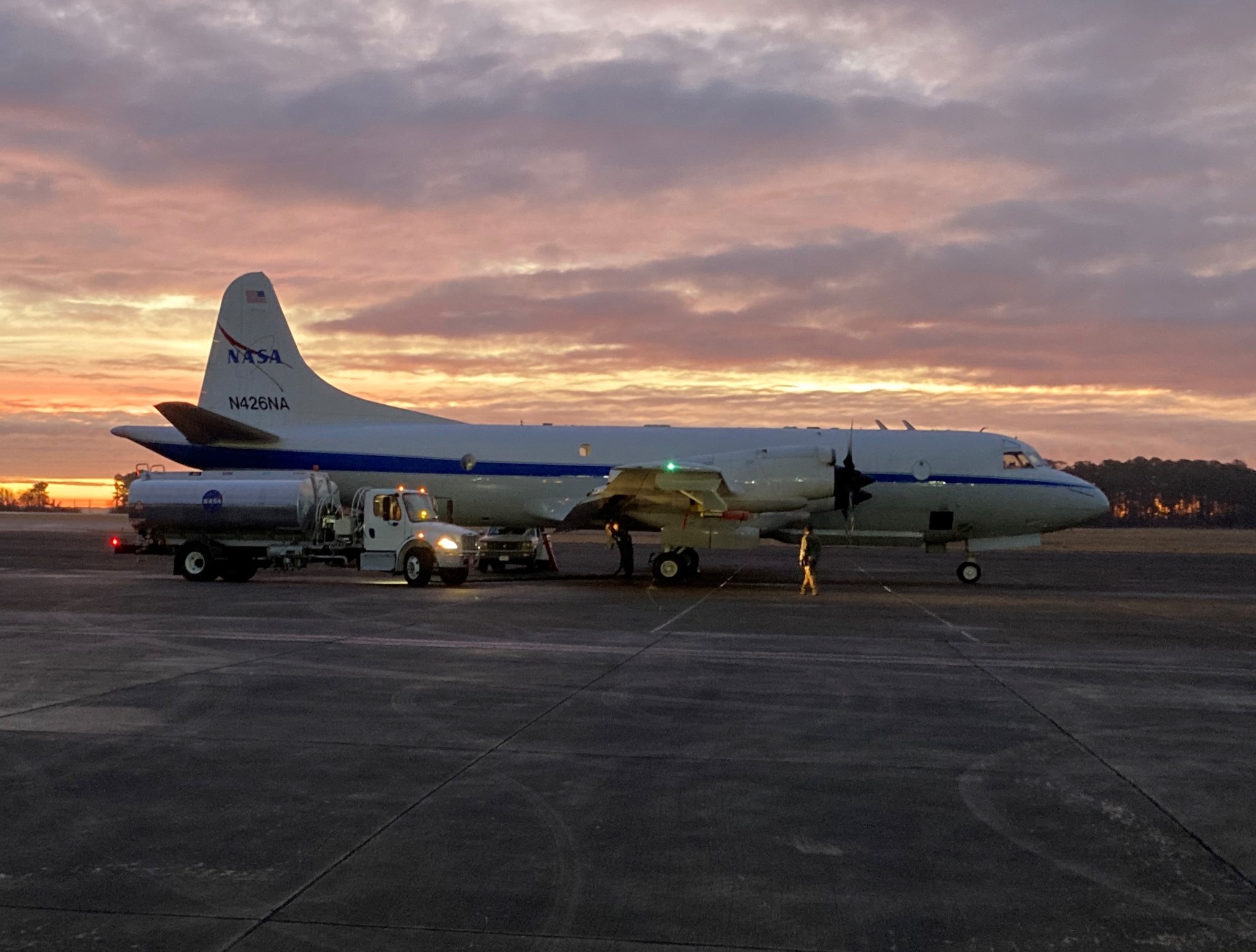
NASA’s Student Airborne Science Activation program (SaSa) is on a mission to broaden the ethnic and racial diversity of researchers in the Earth sciences. SaSa is designed for first- and second-year undergraduates enrolled at Minority-Serving Institutions to participate in an authentic NASA field research campaign. The program’s name is an acronym, but has a double meaning. In Kiswahili (the language also known as Swahili), the word “sasa” means “now.” It was adopted by the program to convey the urgency of their mission to mentor, train, and inspire students from historically underrepresented groups in the geosciences.
This summer, SaSa’s first 25 participants will spend eight weeks gaining hands-on experience in all components of a scientific research campaign. That includes flying aboard the NASA P-3 research aircraft to collect measurements of land, ocean, and atmospheric phenomena. The program also includes mentoring, professional development, and networking opportunities to prepare these students to enter STEM graduate programs – those in science, technology, engineering, and math – and, later, NASA and research careers.
Turning Big Data into Urgent Earth Discoveries
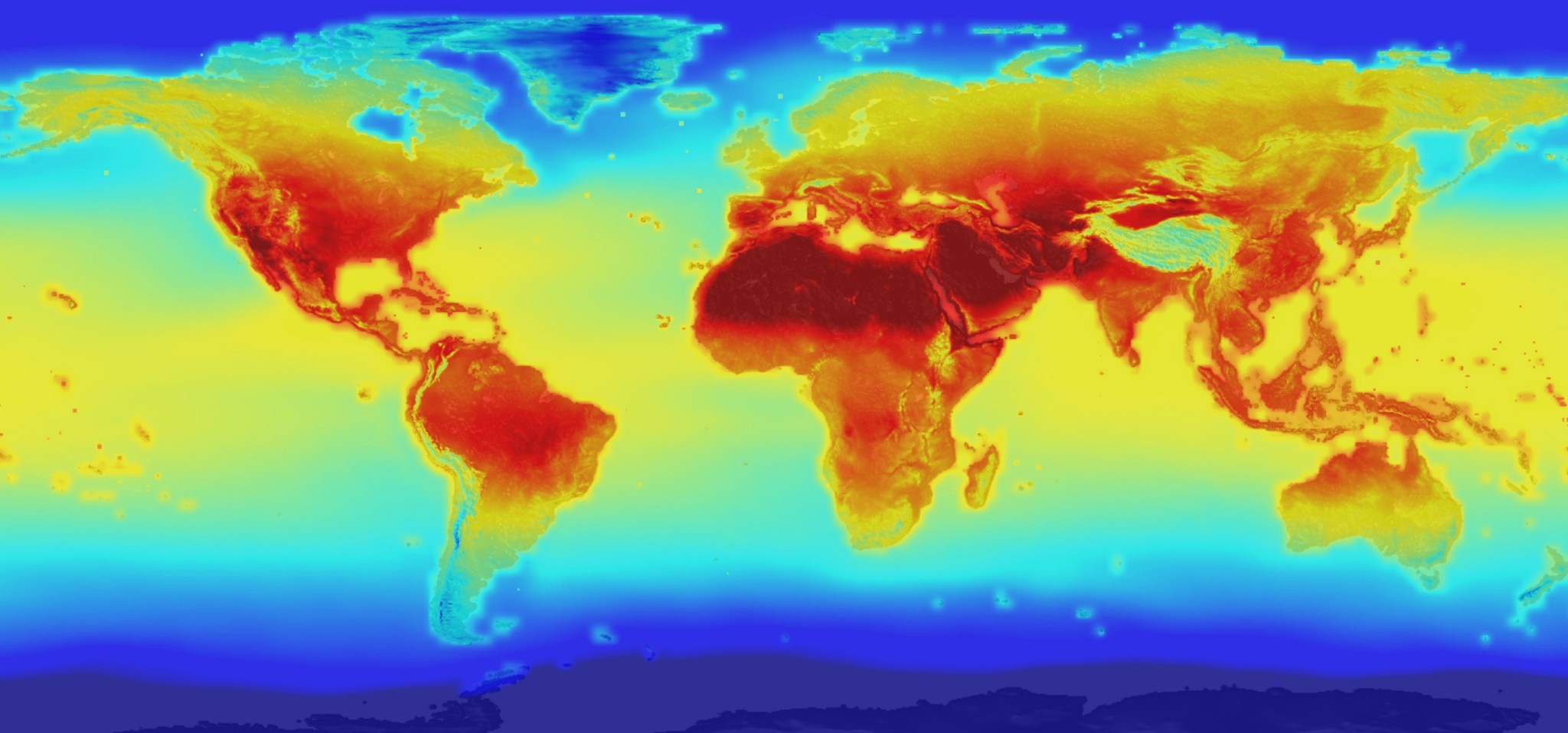
The NASA Earth Exchange (NEX) leans on Big Data, artificial intelligence, machine learning, and NASA’ssupercomputers at Ames to help scientists make new discoveries with huge datasets coming from the agency’s Earth System Observatory. Among the many projects of NEX are initiatives to understand climate projections on a finer scale and to study how climate changes, such as increasing risk of wildfires and heat waves, might affect a single town or region. The data from NEX projects becomes available in a NASA archive and helps inform decisions by policymakers, agencies, and other stakeholders about our climate future.
NEX is also a unique work environment for sharing, exploring, and analyzing huge datasets that empowers near-real-time understanding of complex phenomena from local to global scales and prepares scientists for new data coming from the Earth System Observatory. NEX is a key platform for stepping up to Earth’s challenges – today and in the future.
NASA’s Super-Efficient Supercomputers
High-end computing plays a big role in NASA’s work, but number-crunching supercomputers pump out a lot of heat. Ames’s Modular Supercomputing Facility (MSF), which opened its doors in 2019, is one of the most energy-efficient data centers in the world.
Supercomputing has enabled remarkable breakthroughs in NASA’s science and engineering missions, including in Earth science, exoplanet discovery, aircraft safety, and more. With the demand for NASA supercomputing expected to grow, the MSF was designed to flexibly expand Ames’ processing power while drastically reducing the resources naturally needed for its operation.
Ames’ approach to the MSF’s design cleverly uses the local climate to cool high-powered computers naturally. Annually, the MSF required only 14% of the energy needed for cooling, and reduced water usage by 96%, as compared with the traditional NASA Advanced Supercomputing Facility (NAS). These savings are made possible by cooling technology that uses outside air and evaporative methods ideally suited to the climate in the San Francisco Bay Area.
Investing in Eco-First Innovations
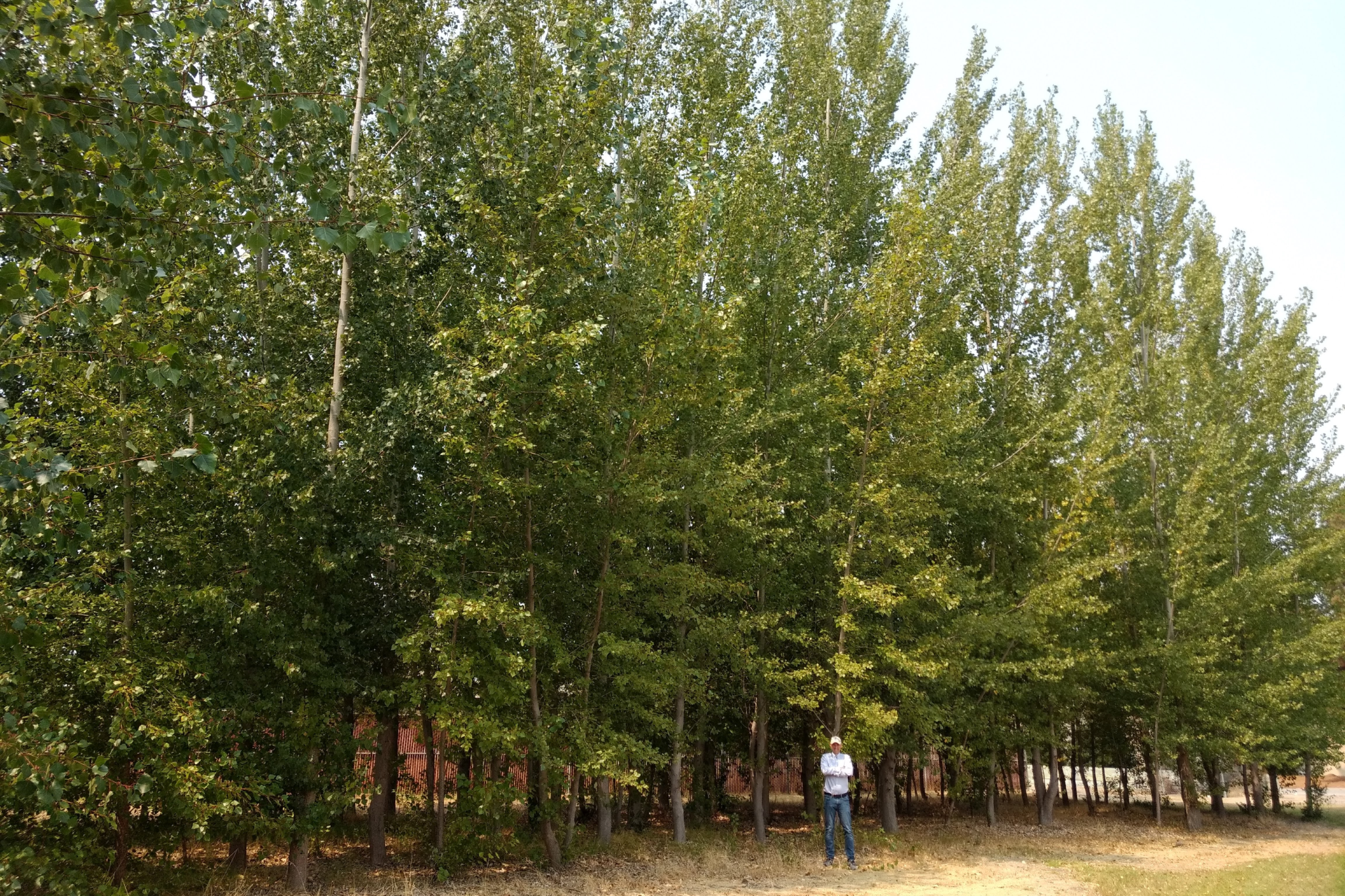
Imagine if trees could help purify contaminated water and eating a fungus could serve as a sustainable protein alternative to meat. These are two projects NASA is helping to make a reality.
The Ames campus served as a testing ground for a project using symbiotic microbes in trees to purify groundwater. Conducted in partnership with Intrinsyx, about 1,000 trees helped eliminate contamination that had existed for decades. The project has expanded to over 30 sites around the US, helping to heal environments impacted by pollutants – and showing how even the smallest forms of biology, through trees, can change lives for the better. This project is funded by the National Science Foundation’s Small Business Innovation (SBIR) program and is supported by researchers at Ames.
Even with new purification techniques, water is still a precious resource – often used up in the production of food. Through NASA’s Small Business Technology Transfer (STTR) program, Natures Fynd is collaborating with NASA and Montana State University to develop bioreactors to cultivate an edible fungus that uses little water and could serve as a source of protein in space. Bioreactors are manufactured devices designed to support a certain biological process. While Nature’s Fynd is developing this bioreactor system with NASA for use in space, where water must be preserved and used sparingly, it also provides an energy-rich source of food on Earth. As a protein source that does not release atmosphere-damaging methane produced by most livestock, it could transform the way we eat on Earth as well.
Marking a Decade of Sustainable Building
When it was built 10 years ago at Ames, Sustainability Base was one of the greenest buildings in the federal government. It can house over 200 employees, and is an exemplar of sustainable design that brings many of the principles used for closed-loop systems on spacecraft down to Earth. Sustainability Base was designed to go beyond simply ‘not hurting’ the environment, but to be beneficial to nature and humans. It generates more energy than it needs to operate and uses 90% less potable water than conventional buildings of comparable size. Materials to build and furnish the building were locally procured and often recycled. For example, the oak planks that line the lobby floor were reclaimed from an old NASA wind tunnel.
The building’s concept was designed for a NASA competition in 2007 by architect William McDonough, a pioneer in sustainable architecture, alongside Dr. Steve Zornetzer, the Associate Center Director for Ames at the time. By implementing closed-loop technology, similar to what’s used by NASA to sustain life in space, the project is proof not only that this level of sustainable building is possible, but it can contribute to the health of our planet.
What is a Data & Reasoning Fabric?
Providing seamlessly connected information and decision-making tools to help future air mobility meet its full potential for society.
by Abigail Tabor
Imagine a not-too-distant future in which a self-operating drone is on its way to deliver goods, taxi people across town, or even help locate wildfires. To safely complete its flight, that drone will require important information – such as a notice of deteriorating weather conditions – that might prompt it to change its course. For that, it could rely on a new capability that NASA researchers are exploring that would enable the distribution of many kinds of information in flight and help the aircraft make the right decisions in response.
That capability is the idea behind DRF, or Data & Reasoning Fabric – a NASA activity exploring if it’s possible to create an information infrastructure that can help assemble useful data and reasoning services to provide in-time information to autonomous aircraft for decision making. The intent is to form a connected, interwoven “fabric” of intelligence that sends aircraft specific, tailored information, wherever they are. This infrastructure would enable the vision of a “smart” city and airspace. While this project is focused on future autonomous systems, DRF could even be applied to traditional transport systems.
Decision Support for Drones
DRF’s vision is to provide seamless access both to services offering data and to tools for making decisions based on that data. The latter is the “reasoning” in Data & Reasoning Fabric.
Many people are already familiar with a reasoning service, in the form of a navigation app on their phone. Different kinds of data – maps, accident reports, traffic conditions, roadwork status – are drawn in by the app, which then sorts through it all and tells the driver the best route to take at the time.
Decisions needed by autonomous aircraft of the future could be made in a similar way. The information made available by DRF’s “fabric” will have the data and reasoning needed to make critical safety decisions rapidly.
Future Marketplaces – of Data and Decisions – to Support Air Mobility
NASA envisions a future air transportation system that moves people and cargo between places previously not served or underserved by aviation – think regional services, or in urban settings – using revolutionary new aircraft that are only just now becoming possible. Efforts toward this goal are called Advanced Air Mobility.
As these aircraft become more autonomous, they’ll need more and more data, along with the reasoning tools to make decisions using that information. To make many disparate types of data and reasoning services available to aircraft, there will need to be a way of connecting them to a multitude of data providers.
So, where does this data and reasoning come from and how is it accessed?
DRF envisions a digital “marketplace” where providers like weather services, mapping and surveying firms, air traffic management, and others can offer their data and reasoning services to aircraft operators via digital agreements. In turn, operators can also offer the data and reasoning they have acquired.
DRF in Action: A Delivery Drone Example
When a delivery drone receives orders to take a package to an address downtown, it connects to the Data & Reasoning Fabric.
A nearby data node provides the drone with information from a weather station, a detailed map from city authorities, and the locations of nearby aircraft, all assembled using data from the marketplace.
Receiving this information from DRF, the drone can understand with its own software that the weather is acceptable, that it should fly above 200 feet to avoid a building, and that it must allow room for an air taxi flying nearby. However, if there is dangerous weather, decision support tools enabled by DRF could provide the drone with a new flight route that avoids weather and obstacle dangers.
If all goes well with executing the DRF activity, drones will have the information and decision-support tools they need to take the safest and most efficient course of action with minimal human input.
DRF will address the needs of an Advanced Air Mobility system, but its vision is not only relevant to those air vehicles. It’s also applicable to the broader transportation network.
Milestones:
- Late 2022 to early 2023: A multi-stakeholder demonstration involving Arizona and the greater Phoenix metropolitan area will show how DRF can enhance and help users adapt to the evolving airspace of AAM.
- Autonomy Association International (AAI), NASA’s partner on this demo, gathered a variety of participants, including stakeholders from academia, industry, communities, tribal nations, and more than 22 cities across Maricopa, Pinal, Pima, and Yuma Counties.
Partners:
DRF is led out of NASA Ames Research Center in California’s Silicon Valley. An exploratory activity, DRF is part of NASA’s Convergent Aeronautics Solutions (CAS) project. CAS strives to provide breakthrough technological innovation in aeronautics, providing researchers the tools and resources to address the biggest challenges facing aviation today and into the future.
DRF’s stakeholders include data, reasoning, and infrastructure service providers, flight operators, and local to federal governments. DRF will establish external partnerships with service providers, academics, and end users to evaluate DRF capabilities. Additionally, these collaborations will help the DRF team develop approaches to overcome technical barriers to implementing future air mobility.
What is CAPSTONE?
A microwave oven–sized CubeSat weighing just 55 pounds will serve as the first spacecraft to test a unique, elliptical lunar orbit as part of the Cislunar Autonomous Positioning System Technology Operations and Navigation Experiment (CAPSTONE). As a pathfinder for Gateway, a Moon-orbiting outpost that is part of NASA’s Artemis program, CAPSTONE will help reduce risk for future spacecraft by validating innovative navigation technologies and verifying the dynamics of this halo-shaped orbit.
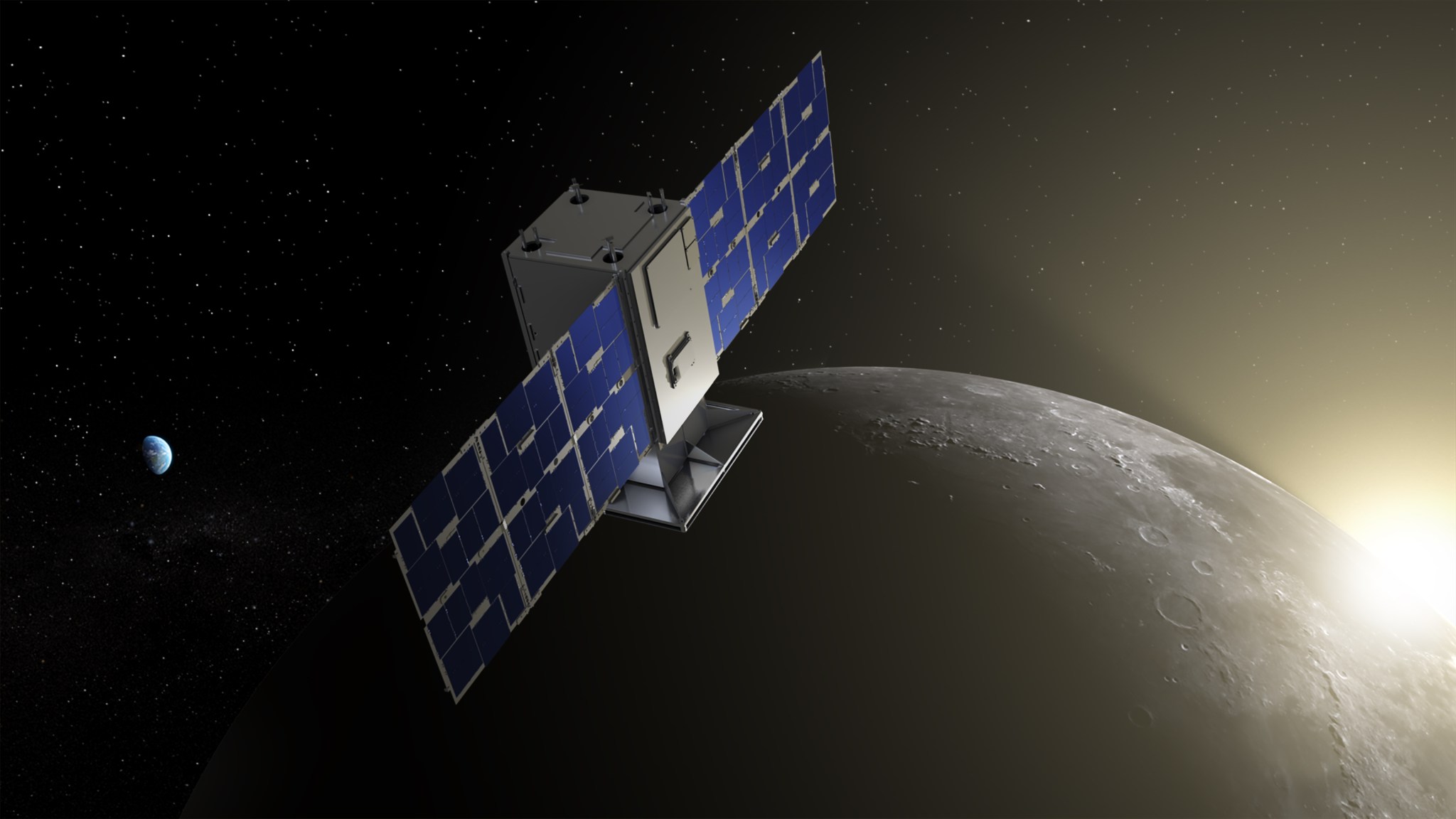
The orbit, formally known as a near rectilinear halo orbit (NRHO), is significantly elongated. Its location at a precise balance point in the gravities of Earth and the Moon, offers stability for long-term missions like Gateway and requires minimal energy to maintain. CAPSTONE’s orbit also establishes a location that is an ideal staging area for missions to the Moon and beyond. The orbit will bring CAPSTONE within 1,000 miles of one lunar pole on its near pass and 43,500 miles from the other pole at its peak every seven days, requiring less propulsion capability for spacecraft flying to and from the Moon’s surface than other circular orbits.
After a three-month journey to its target destination, CAPSTONE will orbit this area around the Moon for at least six months to understand the characteristics of the orbit. Specifically, it will validate the power and propulsion requirements for maintaining its orbit as predicted by NASA’s models, reducing logistical uncertainties. It will also demonstrate the reliability of innovative spacecraft-to-spacecraft navigation solutions as well as communication capabilities with Earth. The NRHO provides the advantage of an unobstructed view of Earth in addition to coverage of the lunar South Pole.
To test these new navigation capabilities, CAPSTONE has a second dedicated payload flight computer and radio that will perform calculations to determine where the CubeSat is in its orbital path. Circling the Moon since 2009, NASA’s Lunar Reconnaissance Orbiter (LRO) will serve as a reference point for CAPSTONE. The intention is for CAPSTONE to communicate directly with LRO and utilize the data obtained from this crosslink to measure how far it is from LRO and how fast the distance between the two changes, which in turn determines CAPSTONE’s position in space.
This peer-to-peer information will be used to evaluate CAPSTONE’s autonomous navigation software. If successful, this software, referred to as the Cislunar Autonomous Positioning System (CAPS), will allow future spacecraft to determine their location without having to rely exclusively on tracking from Earth. This capability could enable future technology demonstrations to perform on their own without support from the ground and allow ground-based antennas to prioritize valuable science data over more routine operational tracking.
CAPSTONE is scheduled to launch no earlier than May 2022 aboard a Rocket Lab’s Electron rocket from the company’s Launch Complex 1 in New Zealand. With a highly ambitious schedule, CAPSTONE will demonstrate key commercial capabilities. NASA partners will test cutting-edge tools for mission planning and operations, paving the way and expanding opportunities for small and more affordable space and exploration missions to the Moon, Mars and other destinations throughout the solar system.
Mission objectives:
- Verify the characteristics of a cis-lunar near rectilinear halo orbit for future spacecraft
- Demonstrate entering and maintaining this unique orbit that provides a highly-efficient path to the Moon’s surface and back
- Demonstrate spacecraft-to-spacecraft navigation services that allow future spacecraft to determine their location relative to the Moon without relying exclusively on tracking from Earth
- Lay a foundation for commercial support of future lunar operations
- Gain experience with small dedicated launches of CubeSats beyond low-Earth orbit, to the Moon, and beyond
Partners:
- Advanced Space of Westminster, Colorado, is developing and operating CAPSTONE.
- Tyvak Nano-Satellite Systems, a Terran Orbital Corporation, of Irvine, California, is building the CubeSat platform.
- Stellar Exploration, Inc. of San Luis Obispo, California, is providing CAPSTONE’s propulsion system.
- Rocket Lab of Long Beach, California, is providing launch services. The launch is managed by NASA’s Launch Services Program at NASA’s Kennedy Space Center in Florida.
- NASA’s Small Spacecraft Technology program within the agency’s Space Technology Mission Directorate is managing the CAPSTONE project. The program is based at NASA’s Ames Research Center in California’s Silicon Valley.
- NASA’s Advanced Exploration Systems within the agency’s Exploration Systems Development Mission Directorate is funding the launch and supporting mission operations.
- The development of CAPS is supported by NASA’s Small Business Innovation Research (SBIR) program.
- NASA’s Goddard Space Flight Center in Greenbelt, Maryland, manages LRO.
Learn more:
- What are SmallSats and CubeSats?
- NASA Funds CubeSat Pathfinder Mission to Unique Lunar Orbit
- NASA Awards Contract to Launch CubeSat to Moon from Virginia
- NASA CubeSats Play Big Role in Lunar Exploration
- Innovative Propulsion System Gets Ready to Help Study Moon Orbit for Artemis
- CAPSTONE’s CubeSat Prepares for Lunar Flight
- NASA’s CAPSTONE Prepares to Enter Unique Orbit





